2 | For Mr. Ptasznik, the amounts set forth under “Resignation through Retirement Notice” reflect the amounts paid or payable pursuant to his Retirement Agreement for each such item upon his retirement in
| 2. | For Mr. Ptasznik, the amounts set forth under “Resignation through Retirement Notice” reflect the amounts paid pursuant to his Retirement Agreement for each such item upon his retirement on February 28 2021, as further described above under “Michael Ptasznik Retirement Agreement”. Mr. Ptasznik is also entitled to continued vesting of his PSU awards under the terms of his Retirement Agreement.” |
115
| 3. | The amounts shown in the table assume a hypothetical termination of Ms. Dillard’s employment, effective as of December 31, 2021, under several different circumstances. As previously disclosed, Ms. Dillard’s employment with the Company terminated on April 8, 2022 through voluntary resignation, which did not entitle Ms. Dillard to the payments and benefits shown in the table. |
Our methodology to identify the median of the annual total compensation of all employees in 2021 included the following assumptions, adjustments, and estimates. CEO Pay Ratio
Under the Dodd-Frank Wall Street Reform and Consumer Protection Act, we are required to disclose the median of the annual total compensation of our employees, the annual total compensation of our principal executive officer, President and CEO Adena T. Friedman, and the ratio of these two amounts. The SEC’s CEO pay ratio rules permit us to use the same median employee for comparison purposes for up to three years, unless there has been a change in the registrant’s employee population or compensation arrangements that the registrant reasonably believes would result in a significant change in the disclosure. We have used the same median employee for years 2020, 2019 and 2018, as our employee population and compensation arrangements have not significantly changed.
For the year 2020, our employee population did not change significantly, as illustrated by the following graphic.

NASDAQ’S GLOBAL WORKFORCE1
| | | | | | 2020 | | 2019 | | 2018 | | 4,771 | | 4,321 | | 4,057 |
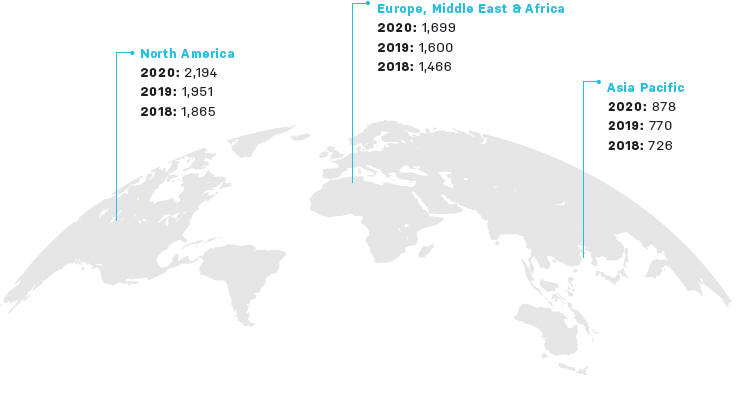
1 | Employee data as of October 22 of the relevant year.
| · | | We identified the median employee by reviewing the 2021 actual total compensation (which consists of the employee’s base salary, actual bonus paid in 2021 and grant date value of actual equity awards granted in 2021) of all full-time, part-time and hourly employees employed by us as of October 22, 2021. |
116
Our employee compensation arrangements also did not change significantly. As a result, and consistent with the applicable rules, we used the same median employee as in 2018 and 2019 for the following CEO pay ratio disclosure.
As described in our 2018 Proxy Statement, our methodology to identify the median of the annual total compensation of all employees in 2018 included the following assumptions, adjustments, and estimates.
•| · | | Consistent with the applicable rules, in 2021 we excluded certain employees from our total employee population in determining our median employee. |
We identified the median employee by reviewing the 2018 actual total compensation (which consists of the employee’s base salary, actual bonus paid in 2018 and grant date value of actual equity awards granted in 2018) of all full-time, part-time and hourly employees employed by us as of October 22, 2018.
| |
• | | Consistent with the applicable rules, in 2018 we excluded certain employees from our total employee population in determining our median employee.
| |
| > | | We excluded eight employees who became our employees due to an acquisition in October 2018, as permitted by the merger/acquisition exemption.
| |
| > | | We excluded 46 employees who joined Nasdaq after October 22, 2018 due to an acquisition.
| |
| > | | –As permitted under the non-U.S. de minimis exemption, we excluded 202270 employees located in jurisdictions outside of the United States, as follows: (1) three employees in Belgium, (2) 194five employees in the Philippines,Italy, (3) twothree employees in South Korea, (4) three employees in the Netherlands, (5) 251 employees in the Philippines, (6) two employees in Saudi Arabia, (7) one employee in Turkey and (5)(8) two employees in the United Arab Emirates. | |
| > | | –Following the application of these exclusions, the total number of employees used in our median employee analysis was 3,847 (1,8575,463 (3,041 employees from North America, 1,4601,718 employees from Europe, the Middle East and Africa and 530704 employees from Asia Pacific). | |
•| · | | We annualized 2021 base cash compensation for full-time and part-time permanent employees who were hired after January 1, 2021. |
| · | | All base cash compensation for employees outside the U.S. was converted to U.S. dollars based on a conversion rate published in our internal human resources system that is updated annually. |
| · | | We annualized 2018 base cash compensation for full-time and part-time permanent employees who were hired after January 1, 2018.
| |
• | | All base cash compensation for employees outside the U.S. was converted to U.S. dollars based on a conversion rate published in our internal human resources system that is updated annually.
| |
• | | We did not make any cost-of-living adjustments or full-time equivalent adjustments in identifying the median employee. | |
Using this methodology, we determined that the median employee was an exempt, full time professional employee located in the U.S. Based on those factors and using the 2018 median compensated employee as the 2020 median employee, we determined the 2020 CEO Pay Ratio as such: • | | The 2020 annual total compensation of Ms. Friedman was $15,807,618.
| |
• | | Based on the same methodology we use for NEOs in the Summary Compensation Table, the 2020 annual total compensation of the median employee was $125,096.an exempt, full time professional employee located in the U.S. Based on those factors, we determined the 2021 CEO Pay Ratio as such:
| |
• | | | · | | The 2021 annual total compensation of Ms. Friedman was $19,965,893. |
| · | | Based on the same methodology we use for NEOs in the Summary Compensation Table, the 2021 annual total compensation of the median employee was $98,946. |
| · | | The ratio of the 2021 annual total compensation of Ms. Friedman to the 2021 annual total compensation of the median employee was 202 to 1. |
Our CEO pay ratio is a reasonable estimate calculated in a manner consistent with the SEC’s rules. The SEC’s rules for identifying the median employee and calculating the pay ratio of the 2020based on that employee’s annual total compensation allow companies to adopt a variety of Ms. Friedmanmethodologies to identify the median employee. The SEC’s rules also allow companies to exclude up to 5% of their workforce and make reasonable estimates and assumptions that may impact their employee populations. As a result, the pay ratio reported by other companies may not be comparable to the 2020 annual totalpay ratio reported above. Other companies have different employee populations and compensation of the median employeepractices and utilize different methodologies, exclusions, estimates and assumptions in calculating their own pay ratios.
Audit & Risk Committee Report The Audit & Risk Committee operates under a written charter. The charter, which was 126 to 1. | |
Our CEO pay ratio is a reasonable estimate calculated in a manner consistent with the SEC’s rules. The SEC’s rules for identifying the median employee and calculating the pay ratio based on that employee’s annual total compensation allow companies to adopt a variety of methodologies to identify the median employee. The SEC’s rules also allow companies to exclude up to 5% of their workforce and make reasonable estimates and assumptions that may impact their employee populations. As a result, the pay ratio reported by other companies may not be comparable to the pay ratio reported above. Other companies have different employee populations and compensation practices and utilize different methodologies, exclusions, estimates and assumptions in calculating their own pay ratios.
117
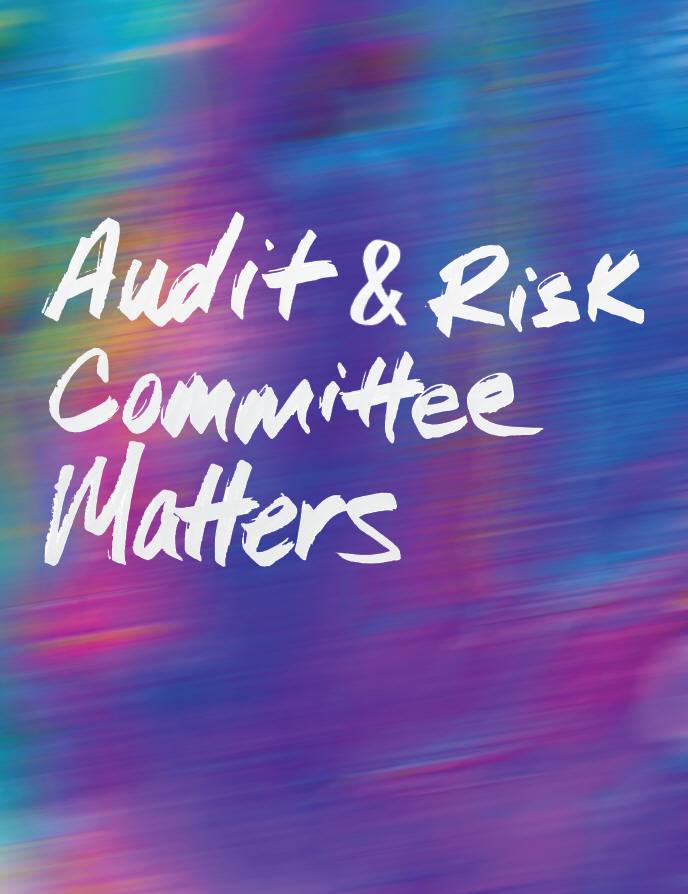
Audit & Risk Committee Matters
Audit & Risk Committee Responsibilities
The Audit & Risk Committee operates under a written charter. The charter, which was last amended effective February 23, 2021,last amended effective February 23, 2022, includes the Audit & Risk Committee’s duties and responsibilities.
The Audit & Risk Committee assists the Board in fulfilling its responsibility for oversight of the quality and integrity of Nasdaq’s accounting, auditing, and financial reporting practices and risk management. As part of this effort, the Audit & Risk Committee reviews the disclosures in our Form 10-K, Quarterly Reports on Form 10-Q and quarterly earnings releases. In addition, the Audit & Risk Committee assists the Board by reviewing and discussing the effectiveness of controls over Nasdaq’s regulatory programs, ERM structure and process, Global Ethics and Compliance Program and confidential whistleblower process. The Audit & Risk Committee charter complies with the applicable provisions of the Sarbanes-Oxley Act of 2002 and related rules of the SEC and The Nasdaq Stock Market. For a description of the Audit & Risk Committee’s key accomplishments in 2020, please refer to page 41.
Review of Audited Financial Statements
The Audit & Risk Committee:
• | | reviewed and discussed the audited financial statements with management;
| |
• | | discussed with the independent registered public accounting firm all communications required by generally accepted auditing standards, including those described in Auditing Standard No. 1301, “Communications with Audit & Risk Committees,” as adopted by the PCAOB; and
| |
• | | received the written disclosures and the letter from the independent registered public accounting firm required by applicable requirements of the PCAOB regarding the firm’s communications with the Audit & Risk Committee concerning independencereviews the disclosures in annual reports on Form 10-K, quarterly reports on Form 10-Q and discussed with the independent registered public accounting firm the firm’s independence.
| |
Based on the review and discussions discussed above, the Audit & Risk Committee recommended to the Board of Directors that the audited financial statements be included in the Form 10-K.
The Audit & Risk Committee

119
Annual Evaluation and 2021 Selection of the
Independent Auditor
The Audit & Risk Committee annually evaluates the performance of the Company’s independent auditors, including the senior audit engagement team, and determines whether to reengage the current independent auditors or consider other audit firms.
The Audit & Risk Committee assessed Ernst & Young LLP’s performance as independent auditor during fiscal year 2020, including the performance of the Ernst & Young LLP lead audit partner and the audit team. As part of its assessment, the Audit & Risk Committee considered several factors, including:
• | | relevant industry expertise and geographical reach;
| |
• | | an annual report from Ernst & Young LLP describing the independent auditors’ internal quality control procedures;
| |
• | | the firm’s independence and integrity;
| |
• | | the quality of communication withquarterly earnings releases. In addition, the Audit & Risk Committee;
| |
• | | Committee assists the appropriateness of fees; | |
• | | any material issues raisedBoard by reviewing and discussing Nasdaq’s regulatory and compliance programs, ERM structure and process, Global Employee Ethics Program, SpeakUp! Program and confidential whistleblower process. The Audit & Risk Committee charter complies with the most recent internal quality control review or peer review or other external data on audit quality and performance; and
| |
• | | the quality and efficiencyapplicable provisions of the services provided,Sarbanes-Oxley Act of 2002 and related rules of the SEC and The Nasdaq Stock Market.
For a description of the Audit & Risk Committee’s key accomplishments in 2021, please refer to page 32. Review of Audited Financial Statements The Audit & Risk Committee: | · | | reviewed and discussed the audited financial statements with management; |
| · | | discussed with the independent registered public accounting firm all communications required by generally accepted auditing standards, including those described in Auditing Standard No. 1301, “Communications with Audit & Risk Committees,” as adopted by the PCAOB; and |
| · | | received the written disclosures and the letter from the independent registered public accounting firm required by applicable requirements of the PCAOB regarding the firm’s communications with the Audit & Risk Committee concerning independence and discussed with the independent registered public accounting firm the firm’s independence. |
Based on the review and discussions discussed above, the Audit & Risk Committee recommended to the Board of Directors that the audited financial statements be included in the Form 10-K. The Audit & Risk Committee 
Annual Evaluation and 2022 Selection of Independent Auditors The Audit & Risk Committee annually evaluates the performance of the Company’s independent auditors, including the senior audit engagement team, and determines whether to reengage the current independent auditors or consider other audit firms. The Audit & Risk Committee assessed Ernst & Young LLP’s performance as independent auditor during fiscal year 2021, including the performance of the Ernst & Young LLP lead audit partner and the audit team. As part of its assessment, the Audit & Risk Committee considered several factors, including: | |
The Audit & Risk Committee also considered the impact of changing auditors when assessing whether to retain the current independent auditor. The Audit & Risk Committee determined that Ernst & Young LLP’s longer tenure is a benefit to Nasdaq as Nasdaq benefits from their institutional expertise and knowledge of Nasdaq’s complex operations, accounting policies and practices, and internal controls over financial reporting. The Audit & Risk Committee most recently conducted a request for proposal for the independent auditor relationship in 2019.
Ernst & Young LLP provided a formal written statement describing all relationships between the firm and Nasdaq that might bear on the firm’s independence, consistent with the applicable requirements of the PCAOB. The Audit & Risk Committee and Ernst & Young LLP discussed any relationships that may impact the firm’s objectivity and independence and satisfied itself as to Ernst & Young LLP’s independence.
| · | | relevant industry expertise and geographical reach; |
According to applicable SEC rules, the lead audit partner at Ernst & Young LLP, our external auditor, may provide a maximum of five consecutive years of service to us. The current Ernst & Young LLP lead audit partner was assigned to us commencing with the audit of our financial statements for the fiscal year ended December 31, 2019.
| · | | an annual report from Ernst & Young LLP describing the independent auditors’ internal quality control procedures; |
Based on the assessment of Ernst & Young LLP’s performance, the Audit & Risk Committee believes that retaining Ernst & Young LLP for the fiscal year ending December 31, 2021 is in the best interest
| · | | the firm’s independence and integrity; |
| · | | the quality of communication with the Audit & Risk Committee; |
| · | | the appropriateness of fees; |
| · | | any material issues raised by the most recent internal quality control review or peer review or other external data on audit quality and performance; and |
| · | | the quality and efficiency of the services provided, including performance of the Ernst & Young LLP lead audit partner and the audit team. |
The Audit & Risk Committee also considered the impact of changing auditors when assessing whether to retain the current independent auditor. The Audit & Risk Committee determined that Ernst & Young LLP’s longer tenure is a benefit to Nasdaq as it brings their institutional expertise and knowledge of Nasdaq’s complex operations, accounting policies and practices, and internal controls over financial reporting. The Audit & Risk Committee most recently conducted a request for proposal for the independent auditor relationship in 2019. According to applicable SEC rules, the lead audit partner at Ernst & Young LLP, our external auditor, may provide a maximum of five consecutive years of service to us. The current Ernst & Young LLP lead audit partner was assigned to us commencing with the audit of our financial statements for the fiscal year ended December 31, 2019. Based on the assessment of Ernst & Young LLP’s performance, the Audit & Risk Committee believes that retaining Ernst & Young LLP for the fiscal year ending December 31, 2022 is in the best interests of Nasdaq and its shareholders. 120
Audit Fees and All Other Fees The table below shows the amount of fees we paid to Ernst & Young LLP for fiscal years 2020 and 2019, including expenses. | | | | | | | | | | | | | | 2020 | | 2019 | | | | Audit fees1 | | $5,024,454 | | $5,829,453 | | | | Audit-related fees2 | | $1,072,720 | | $1,112,029 | | | | Audit and audit-related fees | | $6,097,174 | | $6,941,482 | | | | Tax fees3 | | $167,702 | | $299,639 | | | | All other fees4 | | $1,277,870 | | $1,302,618 | | | | Total5 | | $7,542,746 | | $8,543,739 |
1 | Audit services were provided globally in 2020 and 2019. Fees related to audits of international subsidiaries are translated into U.S. dollars. Audit fees primarily represent fees for: the audit of Nasdaq’s annual financial statements included in the Form 10-K; the review of Nasdaq’s Quarterly Reports on Form 10-Q; statutory audits of subsidiaries as required by statutes and regulations; accounting consultations on matters addressed during the audit or interim reviews; comfort letters and consents; and the internal control attestation and reporting requirements of Section 404 of the Sarbanes-Oxley Act of 2002.
| |
2 | The 2020 and 2019 audit-related fees primarily include due diligence on strategic initiatives, including M&A, as well as other attestation reports issued related to Nasdaq’s regulatory environment.
| |
3 | The decrease in tax fees in 2020 as compared to 2019 was primarily due to lower fees for tax compliance and advisory services.
| |
4 | Other fees in 2020 and 2019 relate to the Swedish Financial Supervisory Authority listing requirements for companies applying for a listing on Nasdaq Stockholm AB. The validation of these companies is required to be performed by an external accounting firm. The fees are collected from the listing companies by us and paid to Ernst & Young LLP on behalf of the listing companies. In addition, other fees include fees for services related to organization control audits under Statement on Standards for Attestation Engagements No. 18.fiscal years 2021 and 2020, including expenses.
| |
5 | Fees exclude services provided to Nasdaq’s non-profit entities and services provided in relation to Nasdaq’s role as administrator for the Unlisted Trading Privileges Plan.
| |
The Audit & Risk Committee pre-approves both audit and non-audit services performed by the independent registered public accounting firm, and our Audit & Risk Committee pre-approved all such services in 2020 and 2019.
121
| | | | | | | | | | | | 2021 | | 2020 | | | | Audit fees1 | | $5,354,450 | | $5,024,454 | | | | Audit-related fees2 | | $1,266,350 | | $1,072,720 | | | | Audit and audit-related fees | | $6,620,800 | | $6,097,174 | | | | Tax fees3 | | $445,507 | | $167,702 | | | | All other fees4 | | $2,098,306 | | $1,277,870 | | | | Total5 | | $9,164,613 | | $7,542,746 |
| | | 1. | Audit services were provided globally in 2021 and 2020. Fees related to audits of international subsidiaries are translated into U.S. dollars. Audit fees primarily represent fees for: the audit of Nasdaq’s annual financial statements included in the Form 10-K; the review of Nasdaq’s Quarterly Reports on Form 10-Q; statutory audits of subsidiaries as required by statutes and regulations; accounting consultations on matters addressed during the audit or interim reviews; comfort letters and consents; and the internal control attestation and reporting requirements of Section 404 of the Sarbanes-Oxley Act of 2002. |
| 2. | The 2021 and 2020 audit-related fees primarily include due diligence on strategic initiatives, including M&A, as well as other attestation reports issued related to Nasdaq’s regulatory environment. |
| 3. | The increase in tax fees in 2021 as compared to 2020 was primarily due to higher consultation fees regarding tax matters. |
| 4. | Other fees in 2021 and 2020 relate to the Swedish Financial Supervisory Authority listing requirements for companies applying for a listing on Nasdaq Stockholm AB. The validation of these companies is required to be performed by an external accounting firm. The fees are collected from the listing companies by us and paid to Ernst & Young LLP on behalf of the listing companies. In addition, other fees include fees for services related to organization control audits under Statement on Standards for Attestation Engagements No. 18. |
| 5. | Fees exclude services provided to Nasdaq’s non-profit entities and services provided in relation to Nasdaq’s role as administrator for the Unlisted Trading Privileges Plan. |
The Audit & Risk Committee pre-approves both audit and non-audit services performed by the independent registered public accounting firm, and our Audit & Risk Committee pre-approved all such services in 2021 and 2020. Proposal 3: Ratification of the Appointment of Ernst & Young LLP as Our Independent Registered Public Accounting Firm for the Fiscal Year Ending December 31, 20212022 | ✓ | | The Board unanimously recommends that shareholders vote FOR ratification of the appointment of Ernst & Young LLP. |
As outlined in the Audit & Risk Committee charter, the Audit & Risk Committee is directly responsible for the appointment, compensation, retention, and oversight of the independent registered public accounting firm retained to audit Nasdaq’s financial statements. Following the process described under “Audit & Risk Committee Matters — Annual Evaluation and 20212022 Selection of the Independent Auditor,Auditors,” the Audit & Risk Committee has appointed Ernst & Young LLP as the Company’s independent registered public accounting firm for the fiscal year ending December 31, 2021. 2022. If the shareholders do not ratify the selection, the Audit & Risk Committee will reconsider whether to retain Ernst & Young LLP. Even if the selection is ratified, the Audit & Risk Committee, in its discretion, may change the appointment at any time during the year if it determines that such a change would be in the best interests of Nasdaq and its shareholders. Representatives of Ernst & Young LLP will be present during the Annual Meeting and will have the opportunity to make a statement and be available to respond to appropriate questions by shareholders. The Audit & Risk Committee and the Board believe that the continued retention of Ernst & Young LLP as the independent registered public accounting firm is in the best interests of Nasdaq and its shareholders. | |  | | The Board unanimously recommends that shareholders vote FOR ratification of the appointment of Ernst & Young LLP. |
122

Other Items 111

Other Items
| | | | | Proposal 4: Approve an Amendment to Nasdaq’s Charter to Increase the Total Number of Authorized Shares of Common Stock to Effect a Proposed 3-for-1 Stock Split | ✓ | The Board unanimously recommends that shareholders vote FOR the amendment to Nasdaq’s charter. |
After due consideration, and upon the recommendation of our Finance Committee, our Board of Directors has determined that it is advisable and in the best interests of Nasdaq and its shareholders to amend Nasdaq’s Amended and Restated Certificate of Incorporation to increase the total number of authorized shares of common stock from three hundred million (300,000,000) to nine hundred million (900,000,000), and correspondingly increase the total number of shares of capital stock that Nasdaq is authorized to issue from three hundred thirty million (330,000,000) to nine hundred thirty million (930,000,000) in order to provide us with sufficient authorized but unissued shares to effect a proposed 3-for-1 stock split. Thus, our Board of Directors has approved, adopted and authorized an amendment to our Amended and Restated Certificate of Incorporation, the text of which is set forth in Annex B to this Proxy Statement. General Article Fourth, Paragraph A of our Amended and Restated Certificate of Incorporation provides that the total number of shares of stock that we have the authority to issue is three hundred thirty million (330,000,000), consisting of thirty million (30,000,000) shares of Preferred Stock, and three hundred million (300,000,000) shares of common stock. The proposed amendment (the “Proposed Charter Amendment”) to our Amended and Restated Certificate of Incorporation would: increase the total number of authorized shares of common stock from three hundred million (300,000,000) to nine hundred million (900,000,000); and increase the total number of shares of capital stock from three hundred thirty million (330,000,000) to nine hundred thirty million (930,000,000). The Proposed Charter Amendment would not change the total number of authorized shares of preferred stock. In connection with our operation of self-regulatory organizations in the United States, Nasdaq is subject to SEC oversight, as prescribed by the Exchange Act. Under the Exchange Act, these self-regulatory organizations must submit to the SEC proposed changes to any of their rules, practices and procedures, including amendments to provisions of our Amended and Restated Certificate of Incorporation that are deemed to constitute rules. We expect to begin the process of obtaining approval from the SEC on or about the date of the filing of our Definitive Proxy Statement. We cannot guarantee that the SEC will approve of the proposed changes. If the Proposed Charter Amendment is adopted by our shareholders at the 2022 Annual Meeting and approved by the SEC, the Proposed Charter Amendment will be filed with the Secretary of State of the State of Delaware and become effective in connection with such filing. We expect to make such filing as soon as practicable after receiving the approval of both the SEC and our shareholders. The additional shares of common stock authorized by the Proposed Charter Amendment, if and when issued, would have the same rights and privileges as the shares of common stock currently authorized under our Amended and Restated Certificate of Incorporation. The par value per share of our common stock will not be affected by the Proposed Charter Amendment. As of the record date, we had three hundred million (300,000,000) shares of our common stock authorized, of which [●] shares were issued and outstanding and approximately [●] shares have been granted or remain available for grant under our Equity Plan and ESPP. In addition, we have 30,000,000 shares of preferred stock authorized, of which no shares were issued and outstanding. Therefore, as of the record date, we had only approximately [●] shares of common stock available for issuance, which is not enough to effect the proposed stock split without effecting the Proposed Charter Amendment. Purpose of the Proposed Charter Amendment On March 23, 2022, the Board of Directors approved pursuing an effective 3-for-1 forward stock split by way of a stock dividend contingent upon the approval of the adoption of the Proposed Charter Amendment by both our shareholders and the SEC, pursuant to which the holders of record of shares of common stock would receive by way of a dividend, two shares of common stock for each share of common stock held by such holder (the “Stock Dividend”). In the event the Stock Dividend is declared and paid, we will also make appropriate adjustments to our Equity Plan, ESPP and outstanding equity-based awards, including adjustments to the number of shares of common stock authorized for issuance under such plans and to the terms of such awards, in accordance with the parameters of the Stock Dividend and the terms of such plans. As a result, the Stock Dividend would significantly increase the number of shares of common stock issued and outstanding and the number of shares of common stock authorized for issuance under our Equity Plan and ESPP, thus necessitating an increase in the number of authorized shares under our Amended and Restated Certificate of Incorporation. If the Proposed Charter Amendment is filed with the Secretary of State of the State of Delaware and becomes effective, the shares of common stock authorized by our Amended and Restated Certificate of Incorporation (as amended by the Proposed Charter Amendment) that are in excess of those distributed pursuant to the Stock Dividend will be available for issuance at such times and for such corporate purposes as our Board of Directors (or an authorized committee thereof) may deem advisable, including, without limitation, potential acquisitions, strategic partnerships, equity financings, equity incentives to employees, payments of future stock dividends and other forms of recapitalizations, without further shareholder approval (except as may be required by applicable law or the rules of any stock exchange or stock market on which the common stock may be listed or traded). Stock Dividend The trading price of our common stock has risen significantly over the past several years, reflecting the consistently strong performance of our Company. Since we first became a publicly traded company, the total number of authorized shares of our common stock has remained constant at three hundred million (300,000,000). However, over the last five years, the trading price of our common stock has increased by approximately [●]. As the trading price of our common stock has risen, we have carefully evaluated the effect of the trading price of our common stock on the liquidity and marketability of our common stock. We believe that this considerable price appreciation may be affecting the liquidity of our common stock, making it more difficult to efficiently trade and less affordable to certain classes of investors and, therefore, potentially less attractive to certain investors. The price of one share of our common stock on March 31, 2017 was $69.45 and the closing market price of one share our common stock on April 1, 2022 was $181.92 as reported on the Nasdaq Stock Market. Our Board believes that declaring and paying the Stock Dividend may support liquidity in the trading of our common stock and make the common stock more attractive to a broader range of investors. The Board believes it is in our and our shareholders’ best interests to increase the number of authorized shares of common stock for the purpose of, among other things, providing Nasdaq with sufficient authorized but unissued shares of common stock to declare and pay the proposed Stock Dividend. If our shareholders adopt and the SEC approves the Proposed Charter Amendment, it is expected that the Board of Directors (or an authorized committee thereof) will declare the Stock Dividend and fix a record date and distribution date for such Stock Dividend soon thereafter. While the Board of Directors currently intends that the Board of Directors (or an authorized committee thereof) will declare the Stock Dividend and fix a distribution date that is shortly after the Proposed Charter Amendment is filed with the Secretary of State of the State of Delaware and becomes effective, the decision of the Board of Directors (or an authorized committee thereof) as to whether and when to declare and pay the Stock Dividend will be based on a number of factors, including market conditions and existing and expected trading prices for the common stock. Effect of the Proposed Charter Amendment If the Proposed Charter Amendment is adopted and becomes effective and, if the Stock Dividend is declared and paid, the aggregate number of shares of common stock either issued and outstanding or that may be issued pursuant to equity awards or otherwise reserved for issuance under Nasdaq’s Equity Plan and ESPP would total approximately [●], which is in excess of the three hundred million (300,000,000) shares of common stock currently authorized under our Amended and Restated Certificate of Incorporation. Having an additional [●] shares of common stock available for issuance after the payment of the Stock Dividend would provide Nasdaq with similar flexibility to what we currently have to issue shares of common stock without the expense and delay of a shareholders’ meeting. Future issuances of shares of common stock could have a dilutive effect on the EPS, voting power and percentage shareholdings of current shareholders. In addition, the availability of additional shares of common stock for issuance could, under certain circumstances, discourage or make more difficult any efforts to obtain control of Nasdaq. We do not believe, however, that the Proposed Charter Amendment would have an anti-takeover effect, and we have not proposed the increase in the authorized number of shares of common stock with the intention of using the additional shares for anti-takeover purposes. Right to Abandon the Proposed Charter Amendment and Stock Dividend We may abandon the Proposed Charter Amendment at any time before the effectiveness of the filing of the Proposed Charter Amendment with the Secretary of State of the State of Delaware and may also abandon the Stock Dividend, in each case without further action by our shareholders, notwithstanding the authorization of the Proposed Charter Amendment by our shareholders and the SEC. No Appraisal Rights Under the General Corporation Law of the State of Delaware, our shareholders are not entitled to appraisal rights in connection with the Proposed Charter Amendment or the Stock Dividend. Vote Required Approval of the adoption of the Proposed Charter Amendment requires the affirmative vote of the holders of a majority of the outstanding shares of common stock entitled to vote thereon. If you abstain from voting on this matter, your abstention will have the same effect as a vote “against” the approval of the adoption of the Proposed Charter Amendment. If you hold your shares through a broker and you do not instruct the broker on how to vote on this proposal within a specified period of time prior to the meeting, your broker has the authority to vote your shares. Abstentions and broker non-votes will be counted as present for purposes of determining the presence of a quorum. Proposal 5: Shareholder Proposal – Adopt a MainstreamSpecial Shareholder Right – Written ConsentMeeting Improvement | X | The Board unanimously recommends that shareholders vote AGAINST Proposal 5. |
Mr. Kenneth Steiner, 14 Stoner Ave., 2M, Great Neck, NY 11021,11021-2100, owner of no less than 500100 shares of Nasdaq common stock, has informed Nasdaq that he plans to introduce the following proposal at the Annual Meeting. We are not responsible for the accuracy or content of the proposal and supporting statement, which are presented below as received from the proponent. The proposal and supporting statement are quoted verbatim in italics below. SHAREHOLDER PROPOSAL Proposal 5 - Special Shareholder Meeting Improvement 
To make sure readersShareholders ask our board to take the steps necessary to amend the appropriate company governing documents to give the owners of a combined 10% of our outstanding common stock the power to call a special shareholder meeting.
One of the main purposes of this proposal is to give shareholders the right to formally participate in calling for a special shareholder meeting regardless of their length of stock ownership to the fullest extent possible. Currently it takes a theoretical 15% of all shares outstanding to call for a special shareholder meeting. This theoretical 15% of all shares outstanding translates into 24% of the shares that vote at our annual meeting. It would be hopeless to think that shares that do not have time to vote would have time to go through the special procedural steps to call for a special shareholder meeting. And it goes downhill from here. All shares held for less than one full year are 100% disqualified from formal participation in calling for a special shareholder meeting. Thus the shareholders who own 24% of the shares that vote at the annual meeting could determine that they own 33% of NDAQ stock when length of stock ownership is factored out. And then all NDAQ shares not held long are 100% disqualified. Thus the shareholders who own 33% of NDAQ stock could determine that they own close to 40% of NDAQ stock when their shares not held long are included. A 15% stock ownership requirement that can easily distinguish between material providedin practice be close to a 40% stock ownership requirement is nothing for management to brag about. And NDAQ management likes to brag about its shareholder engagement even when management disingenuously distributes voter guides for dummies shortly before the voting at the annual meeting that tell shareholders how to vote in lockstep with the management party line. It is also important to vote for this proposal because we gave 46% support to a 2018 proposal for a shareholder right to act by written consent and we still do not have a right to act by written consent. This 46% support may have represented 51% support from the proponentNDAQ shares that have access to independent proxy voting advice and material providedare not forced to rely on the conflicted opinions of management. Many companies provide for both a shareholder right to call a special shareholder meeting and a shareholder right to act by written consent. Southwest Airlines and Target are companies that do not provide for shareholder written consent and yet provide for 10% of shares to call for a special shareholder meeting. Please vote yes: Special Shareholder Meeting Improvement, Proposal 5 Board Of Directors’ Statement In Opposition The Board has carefully considered this proposal and concluded that its adoption is unnecessary and not in the best interests of the Company we have put a box around material provided by the proponent. | |  | | or our shareholders. The Board unanimously recommends that shareholders vote AGAINST Proposal 4. |
| | | Proposal 4: Adopt a Mainstream Shareholder Right – Written Consentthis proposal, as further explained below.

| | | | Reasons to vote against this proposal | | | | ✓ | | Shareholders already have a meaningful right to call a special meeting with a 15% threshold | | | | ✓ | | The proposed 10% threshold is lower than the threshold at a majority of S&P 500 companies that offer shareholders the right to call a special meeting | | | | ✓ | | Special meetings require significant resources, and the lower threshold could be abused or lead to an unnecessary disruption of management’s time and energy in leading Nasdaq and driving value for all shareholders | | | | ✓ | | Nasdaq’s existing strong corporate governance practices emphasize Board accountability and provide shareholders with numerous opportunities for shareholder action | | | |
Shareholders requestNasdaq shareholders already have the ability to call special meetings.
The Board acknowledges the importance of allowing shareholders a meaningful right to call special meetings in appropriate circumstances. Currently, shareholders holding at least 15% of Nasdaq’s outstanding capital stock for at least one year may call a special meeting of shareholders. This right, which was adopted in response to feedback from our shareholders, permits Nasdaq’s shareholders to bring important matters before all shareholders for consideration in a fully transparent and equitable manner. The Board believes that our boardcurrent 15% ownership threshold achieves a reasonable and appropriate balance between providing shareholders with the ability to call a special meeting, while protecting shareholders against a small minority of directors take such stepsshareholders who may utilize the special meeting right to advance their own self-interests. Given our shareholder base, reducing the ownership threshold to 10% could enable a small minority of shareholders (or even a single shareholder) to trigger the expense and distraction of a special meeting to pursue narrow short-term interests that are not widely viewed among our shareholder base as requiring immediate attention or that are not aligned with the long-term interests of the Company or our shareholders generally. The Board believes maintaining the 15% ownership threshold preserves a reasonable and appropriate balance between providing shareholders with a right to call a special meeting and protecting against the unnecessary waste of corporate resources and disruption associated with convening a special meeting that may be necessaryinappropriate. Statements in the shareholder proposal are incorrect and misleading. We believe that certain assertions made in the shareholder proposal and supporting statement are incorrect and misleading. While we will not address each such statement, the proposal includes various percentages that the proponent claims are required to permit written consentcall a special meeting, from the current 15% as set forth in the Company’s By-Laws up to a 40% requirement. These references to various thresholds are particularly misleading given the purpose of this proposal is to reduce the relevant threshold from 15% to 10%. The proponent repeatedly overstates the current 15% ownership threshold with references to higher numbers that are not included in the Company’s By-Laws. Additionally, the Company did not “disingenuously distribute[s] voter guidelines for dummies shortly before the voting at the annual meeting.” The only materials provided by the Company to our shareholders entitledin 2021 were publicly filed with the SEC. The Company has no plans to castdistribute any materials, other than those that are or will be publicly filed, prior to the minimum number of votes that would be necessary to authorize an action at a meeting at which all shareholders entitled to vote thereon were present and voting. This includes shareholder ability to initiate any appropriate topic for written consent.2022 Annual Meeting. This proposal topic won 95%-support at Dover Corporation and 88%-support at AT&T.
A
Our existing 15% special shareholder meeting threshold is more favorable to shareholders than thresholds of other large public companies. Among S&P 500 companies, approximately 70% provide shareholders with a right to act by written consent still affords NDAQ management strong protection forcall special meetings. Of those, approximately 62% set the threshold above 15%, and approximately 14% set the threshold at 15%, as does Nasdaq. Among our exchange peers, our threshold of 15% to call a management holdout mentality forspecial meeting is the status quo duringlowest, and several peers do not afford shareholders the current rapidly changing business environment. Any action taken by written consent would still need 80% supermajority approval from the shares that normally cast ballots at the NDAQ annual meetingright to equal a majority from the NDAQ shares outstanding. Atcall a special shareholder meeting only a 51%-vote is needed.at all. Even though an item forTogether with our strong corporate governance policies and practices, our annual shareholder written consent approval would needengagement program and the above 80% approval, Mr. Michael Splinter, Chairman ofvarious shareholder-friendly governance provisions that we have adopted (as described below and elsewhere in this Proxy Statement), the NDAQ governance committee, apparently gets a panic attack when he sees this proposal in the annualBoard believes that our current 15% special meeting proxy. 2020 marked the 3rd year that NDAQ management wentthreshold remains appropriate and enhances shareholder rights, yet still reasonably allows shareholders to the NDAQ shareholder bank to buy extra advertising to resist this proposal topic. Mr. Splinter is also apparently ignorant of the fact that written consent can be structured so that all shareholders receive notice.
A cornerstone of the 2020 management resistance to shareholder written consent was that shareholders can call a special shareholder meeting.
With the near universal use of tightly controlled online annual
| | Special shareholder meetings which can be only 10-minutes of stilted formalities, meaningful opportunities to raise important matters can be severely restricted at arequire significant resources and management time. A special shareholder meeting because all constructive shareholder questionsrequires a substantial commitment of time, effort and comments can be easily screened outresources by management. For instance, the Goodyear shareholderCompany, regardless of whether the meeting was spoiled byis held in person or virtually. The Company must pay to prepare, print and distribute to shareholders the required SEC disclosure documents related to the meeting, solicit proxies, hold the meeting, tabulate votes, file the voting results with the SEC and, for a trigger-happy management mute button for shareholders. And AT&T would not allow shareholders to speak.
Please see:
Goodyear’s virtual meeting, creates issuesengage a service provider to host the meeting online. A threshold of just 10% risks that a group of shareholders whose interests do not align with shareholders generally will call a meeting, thus spending Company time and resources and risking distraction of our Board and management from their primary focus of growing our business and enhancing shareholder https://www.crainscleveland.com/manufacturing/goodyears-virtual-meeting-creates-issues-shareholdervalue.
Please see:
AT&T investors denied a dial-in as annual meeting goes online https://whbl.com/2020/04/17/att-investors-denied-a-dial-in-as-annual-meeting
-goes-online/1007928/
OnlineNasdaq’s corporate governance practices emphasize Board accountability and provide numerous opportunities for shareholder meetings also give management a blank check to make misleading and cover-up statements. For instance, management at scores of 2020 online annual meetings falsely stated that they had run out of shareholder questions. Online shareholders were powerless to point out that their questions were not answered.
Please see:
Schwartz-Ziv, Miriam, How Shifting from In-Person to Virtual Shareholder Meetings Affects Shareholders’ Voice (August 16, 2020).
Available at SSRN: https://ssrn.com/abstract=3674998 or http://dx.doi.org/l 0.2 l 39/ssrn.3674998
| | Please vote yes: Adopt A Mainstream Shareholder Right - Written Consent - Proposal 4.action.
|
124
Board of Directors’ Statement in Opposition
Our Board carefully considered the advisory votes regarding similar proposals at our Annual Meetings held in 2020, 2019, 2018, 2017 and 2015 and concluded again that this proposal is not in the best interests of Nasdaq and its shareholders. This conclusion is consistent with that of our shareholders, large and small, who cast the majority of votes AGAINST the proposal at each of the Annual Meetings where it was presented, including 65% of votes AGAINST the proposal at the 2020 Annual Meeting. The Board unanimously recommends that shareholders again vote AGAINST this proposal, as further explained below.
ACTION BY WRITTEN CONSENT IS UNNECESSARY GIVEN THE ABILITY OF SHAREHOLDERS TO CALL SPECIAL MEETINGS
In addition to providing for extensive shareholder engagement throughout the year and our current shareholder right to shareholders being able to propose and vote on important matters at our Annual Meetings, shareholders holding as little as 15% of Nasdaq’s voting power for at least one year may call a special meeting of shareholders. This right, which was adopted in response to feedback from our shareholders, permits Nasdaq’s shareholders to bring important matters before all shareholders for consideration in a fully transparent and equitable manner. Shareholder meetings offer important protections and advantages to all shareholders that are absent from the written consent process. The protections and advantages of shareholder meetings, Nasdaq’s existing corporate governance practices and policies emphasize Board accountability and give shareholders ample opportunity to take action. Significant examples include the following: • | | Meetings are held at a time, date and venue publicly announced in advance, and all shareholders may attend, consider the proposed actions, and vote their shares.
| |
• | | Meetings provide shareholders with a transparent forum for open discussion and consideration of the proposed actions.
| |
• | | Accurate and complete information about the proposed actions is widely distributed well in advance of shareholder meetings, thereby encouraging a fully informed discussion and consideration of the merits of the proposed actions.
| |
• | | The Board can analyze the proposed actions and provide a well-informed recommendation on them before shareholders vote on the proposed action.
| |
We further believe that certain assertions made by Mr. Steiner in his proposal and supporting statement are incorrect. While we have chosen not to respond to all of them, we feel compelled to correct the assertion that Company management used shareholder funds last year for the third time to “buy extra advertising to resist this proposal topic.” The Company did not purchase any additional advertising specifically targeting the shareholder proposal presented at the 2020 Annual Meeting nor has it purchased any such advertising with respect to any similar proposal presented at any prior Annual Meeting. The Company has not, and will not, purchase any such advertising this year.
NASDAQ’S EXTENSIVE SHAREHOLDER ENGAGEMENT PROGRAM ALLOWS SHAREHOLDERS TO PROVIDE ONGOING AND CONSTRUCTIVE FEEDBACK TO OUR BOARD OF DIRECTORS AND MANAGEMENT
Nasdaq regularly engages with our investors to learn and understand their views and then communicates those views to the Board. During 2020, we conducted outreach to a cross-section of shareholders owning approximately 75% of our outstanding shares. In 2020, our key shareholder engagement activities included 5 investor (non-deal) road shows, attendance at 13 investor conferences, the 2020 Investor Day and our 2020 Annual Meeting of Shareholders.
The Company sought the views of its shareholders on a wide variety of topics, including Nasdaq’s corporate strategy and focus on long-term value creation; executive compensation; environmental, social and governance topics; risk oversight; human capital management and Nasdaq’s proposed board diversity rule.
Importantly, the Company also sought shareholders’ views on the topic of this proposal, as we have done in the five prior years when this proposal was submitted. The Company’s conversations with investors are consistent
125
with the past voting results on this issue: while some view written consent as important, the majority of our shareholders did not express support for adopting it. In fact, some shareholders continued to express concern that action by written consent could reduce their ability to participate in a vote. Other shareholders expressed that action by written consent would not provide them with any additional material benefits beyond other rights they currently possess. This sentiment is further demonstrated by the results of our five previous Annual Meetings, where, in each case, holders of a majority of shares voting at the meeting failed to support this proposal.
NASDAQ’S CORPORATE GOVERNANCE PRACTICES EMPHASIZE BOARD ACCOUNTABILITY AND PROVIDE NUMEROUS OPPORTUNITIES FOR SHAREHOLDER ACTION
In addition to providing for extensive shareholder engagement throughout the year and shareholders’ right to call special meetings, Nasdaq’s existing corporate governance practices and policies emphasize Board accountability and give shareholders ample opportunity to take action at a properly called shareholders’ meeting. Significant examples include the following.
• | | Proxy Access. In response to feedback from shareholders, Nasdaq adopted a proxy access provision that allows a shareholder (or group of shareholders) that complies with certain customary requirements to nominate candidates for service on the Board and have those candidates included in Nasdaq’s proxy materials. | |
• | | Elimination of Supermajority Voting. In response to feedback from shareholders, Nasdaq eliminated supermajority voting requirements from its governance documents. | |
• | | Majority Voting in Director Elections. In response to feedback from shareholders, Nasdaq amended its governance documents to provide that, in an uncontested election of directors, director nominees are elected by a majority of the votes cast. Moreover, our Corporate Governance Guidelines require that, in an uncontested election, an incumbent director must submit an irrevocable resignation as a condition to his or her nomination for election. If an incumbent director fails to receive the requisite number of votes in an uncontested election, the irrevocable resignation becomes effective and the resignation will be considered by the Nominating & ESG Committee, which will recommend to the full Board whether or not to accept the resignation. | |
• | | Annual Elections of Directors. All of Nasdaq’s directors are elected annually by our shareholders. | |
• | | Director Nominations. Nasdaq’s By-Laws permit shareholders to nominate persons for election to the Board or propose other business to be considered at an annual or special meeting called by the Board. | |
• | | Independent Board Leadership. Nasdaq has separated the roles of Chairman of the Board and President and CEO. The Chairman of the Board is an independent director, as are all of the Chairs of the Board Committees. | |
• | | No “Poison Pill.” We do not have a “poison pill,” which is a defensive tactic used by a corporation’s board of directors against a takeover. Such plans are generally viewed negatively by shareholder rights advocates. | |
• | | Annual Advisory Vote to Approve Executive Compensation. On an annual basis, shareholders have the opportunity to provide feedback on the compensation of our named executive officersNEOs through an advisory vote. | |
• | | Advance Notice Provisions. Nasdaq’s By-Laws establish an advance notice procedure for director nominations or other proposals that are not submitted for inclusion in the Proxy Statement, but that a shareholder instead wishes to present directly at an Annual Meeting. | |
Nasdaq has consistently demonstrated that when it believes a particular action requested by a shareholder is in the best interests of all shareholders, the Board will support that action. In fact, many of the practices described above were adopted in response to shareholder feedback. Additionally, the Company has procedures in place that provide our shareholders with the opportunity to communicate directly with members of the Board, including the independent Chairman of the Board, as further described on page 56.
Nasdaq believes that its corporate governance practices and policies enable shareholders to act in support of their interests while avoiding the risks associated with shareholder action by written consent.
126
ACTION BY WRITTEN CONSENT CAN RESULT IN SECRETIVE AND UNSOUND VOTING PROCESSES, IN OPPOSITION TO NASDAQ’S COMMITMENT TO TRANSPARENT DECISION-MAKING
In contrast to the open and transparent forum of a shareholder meeting, shareholder action by written consent, where there is no advance notice, discussion or debate, can result in secretive and unsound decision-making by permitting a bare majority of shareholders to act alone. Such action would deprive many shareholders of the opportunity to assess, discuss, deliberate and vote on pending shareholder matters. It also would deprive the Board of the opportunity to carefully discuss the merits, disadvantages, and overall implications of a shareholder proposal and then to vote on a proposed action. This could include matters that are significant in nature, such as removing directors, amending the governance documents or acting on a proposal to sell our Company or certain significant corporate assets, all without a shareholder meeting to consider the merits or consequences of that matter to the shareholders that did not participate in the action by written consent. The Board believes that matters of sufficient importance to warrant action between annual shareholder meetings should not be decided in this manner.
ACTION BY WRITTEN CONSENT COULD CREATE CONFUSION AND DISRUPTION FOR SHAREHOLDERS AND THE COMPANY
The Board also believes that permitting shareholder action by written consent is not appropriate for Nasdaq, a large, widely held public company with both institutional and retail investors. If action by written consent is permitted, multiple shareholder groups could solicit written consents at any time and as frequently as they choose on a range of insignificant or self-interested issues, or with respect to issues that Company management and the Board are already contemplating or reviewing. Some of these written consents may be duplicative or contradictory, which has the potential to create substantial confusion and disruption for shareholders and a significant burden on the Company’s resources, including the time and attention of the Board, its executives and its employees. The Board believes the Company’s limited resources would be better spent on executing its growth strategy to deliver results for the Company’s shareholders and clients.
SUBSTANTIALLY IDENTICAL PROPOSALS WERE REJECTED BY THE COMPANY’S SHAREHOLDERS NUMEROUS TIMES
The Board has carefully considered the shareholder proposal in light of the rejection by Nasdaq’s shareholders of substantially similar proposals submitted by the same proponent at five of the last six Annual Meetings of Shareholders. As a result, the Board continues to believe that the actions requested by the proponent are not in the best interests of Nasdaq and its shareholders and urges shareholders to again reject the proposal.
In addition, proxy advisory firm Glass Lewis has adopted a policy concerning shareholder proposals on written consent, which states that in cases like Nasdaq’s where a company has adopted a special meeting right of 15% or below and has adopted reasonable proxy access provisions, Glass Lewis will generally recommend a vote against shareholder proposals regarding written consent. This change is consistent with Nasdaq’s view that this proposal is unnecessary, given Nasdaq’s existing corporate governance framework and practices. Our corporate governance practices are further described beginning on page 20.
NASDAQ HAS CONDUCTED, AND WILL CONDUCT, ITS VIRTUAL ANNUAL MEETING IN A SHAREHOLDER-FRIENDLY MANNER AND IN ACCORDANCE WITH BEST PRACTICES TO ENABLE SHAREHOLDER PARTICIPATION
The shareholder proposal, while advocating for the adoption of a written consent right, also cites several complaints regarding virtual annual meetings generally, and specifically with respect to how certain other companies conducted their annual meetings in 2020. The shareholder proposal claims that “management at scores of 2020 online annual meetings falsely stated that they had run out of shareholder questions” and argues that constructive shareholder questions and comments can be disregarded by management in a special shareholder meeting.
127
In 2020, due to the COVID-19
Nasdaq has consistently demonstrated that when it believes a particular action requested by a shareholder is in the best interests of all shareholders, the Board will support that action. Many of the practices described above were adopted in response to shareholder feedback. Nasdaq believes that its corporate governance practices and policies enable shareholders to act in support of their interests while avoiding the risks associated with a lower threshold to call a special meeting. Summary The Company is proud of its consistent engagement with, and responsiveness to, its shareholders, as shown by its adoption of corporate governance policies that seek to serve the interests of all of our shareholders. Nasdaq’s existing 15% threshold to call a special shareholder meeting is strongly supportive of shareholder rights and is lower than the threshold at most S&P 500 companies. Accordingly, the adoption of the proposal to lower such percentage is unnecessary, inappropriate and not in the best interests of Nasdaq and its shareholders. Other Business The Nasdaq Board knows of no business other than the matters described in this Proxy Statement that will be presented at the Annual Meeting. To the extent that matters not known at this time may properly come before the Annual Meeting, absent instructions thereon to the contrary, the enclosed proxy will confer discretionary authority with respect to such other matters and it is the intention of the persons named in the proxy to vote in accordance with their judgment on such other matters. Security Ownership of Certain Beneficial Owners and Management The following table and accompanying footnotes show information regarding the beneficial ownership of our common stock as of the the record date by: • each person who is known by us to own beneficially more than 5% of our common stock; • each current director and nominee for director; • each NEO; and • pandemic, Nasdaq held its first virtual Annual Meeting in an effort to ensure the safety and well-being of our employees, directors, shareholders and other stakeholders. In addition, the virtual meeting enabled shareholder participation from any location with internet connectivity, at no cost to the shareholder. Indeed, attendance at the 2020 Annual Meeting improved 47% from our 2019 Annual Meeting, which was a hybrid in-person and webcast meeting. Additionally, the Company encouraged shareholders to submit questions in advance of, and during the 2020 Annual Meeting, and all questions that were received were answered during the question and answer session held at the end of the meeting. The 2020 Annual Meeting was also recorded and then made available on the Company’s website following the conclusion of the Annual Meeting. Finally, the entire Board, members of the Company’s Executive Leadership Team and the Company’s independent registered accountant, Ernst & Young LLP, were all present at the 2020 Annual Meeting to answer questions from shareholders. The 2021 Annual Meeting will again be held virtually due to the ongoing COVID-19 pandemic and local travel restrictions and health guidance. Nasdaq intends to hold the 2021 Annual Meeting via a live video webcast, allowing shareholders to have a greater sense of visual participation if they elect to do so. Nasdaq will utilize similar shareholder-friendly practices for the 2021 Annual Meeting as were used for the 2020 Annual Meeting, and intends to answer all questions submitted in advance of, or during, the 2021 Annual Meeting that comply with the Company’s annual meeting rules (which rules will be available to shareholders in advance of the 2021 Annual Meeting). Nasdaq proactively takes steps to facilitate shareholder participation at the Annual Meeting, including by providing a dedicated call-in line for proponents of shareholder proposals to assist them in their presentation to shareholders, and offering technical support for all shareholders attending the 2021 Annual Meeting.
SUMMARY
The Company is proud of its consistent engagement with, and responsiveness to, its shareholders, as shown by its adoption of corporate governance policies that serve the interests of all shareholders. Nasdaq’s existing corporate governance structure is strongly supportive of shareholder rights and accordingly, the adoption of the proposal permitting action by written consent is unnecessary, inappropriate, and not in the best interests of Nasdaq and its shareholders.
The Board of Directors unanimously recommends a vote AGAINST Proposal 4.
128
Other Business
The Nasdaq Board knows of no business other than the matters described in this Proxy Statement that will be presented at the Annual Meeting. To the extent that matters not known at this time may properly come before the Annual Meeting, absent instructions thereon to the contrary, the enclosed proxy will confer discretionary authority with respect to such other matters and it is the intention of the persons named in the proxy to vote in accordance with their judgment on such other matters.
Security Ownership of Certain Beneficial Owners and Management
Each shareholder is entitled to the number of votes equal to the number of shares of common stock held by such shareholder, subject to the 5% voting limitation contained in our Amended and Restated Certificate of Incorporation that generally prohibits a shareholder from voting in excess of 5% of the total voting power of Nasdaq.
The following table and accompanying footnotes show information regarding the beneficial ownership of our common stock as of the record date by:
each person who is known by us to own beneficially more than 5% of our common stock;
each current director and nominee for director;
all directors and executive officers as a group. Except as otherwise indicated, we believe that the beneficial owners listed below, based on information furnished by such owners, will have sole investment and voting power with respect to such shares, subject to community property laws where applicable. All vested options, vested shares of restricted stock and vested shares underlying PSUs referred to in the table were granted under the Equity Plan. Shares of common stock underlying options that are currently exercisable, or shares of restricted stock units that will vest, within 60 days are considered outstanding and beneficially owned by the person holding the options or restricted stock units, as applicable, for the purposes of computing the percentage ownership of that person, but are not treated as outstanding for the purpose of computing the percentage ownership of any other person. Holders of RSUs and PSUs granted under the Equity Plan have the right to direct the voting of the shares underlying those RSUs and PSUs only to the extent the shares are vested. As of the record date, 164,110,600 shares of common stock were outstanding. Except as noted below, each shareholder is entitled to the number of votes equal to the number of shares of common stock held by such shareholder, subject to the 5% voting limitation contained in our Amended and Restated Certificate of Incorporation that generally prohibits a shareholder from voting in excess of 5% of the total voting power of Nasdaq.
129
| | | | | | | | | | | | | | | | | Name of Beneficial Owner | | Common Stock Beneficially Owned | | Percent of Class | | | | Borse Dubai Limited1 | | | | | Level 7, Precinct Building 5, Gate District DIFC, Dubai UAE | | 29,780,515 | | 18.1% | | | | Investor AB2 | | | | | Innax AB, Arsenalsgatan 8C, S-103 32 | | 19,394,142 | | 11.8% | Stockholm, Sweden | | | | | | | | The Vanguard Group, Inc.3 | | | | | 100 Vanguard Blvd. | | 14,397,962 | | 8.8% | Malvern, PA 19355 | | | | | | | | Massachusetts Financial Services Company4 | | | | | 111 Huntington Avenue | | 13,809,174 | | 8.4% | Boston, MA 02199 | | | | | | | | Capital World Investors5 | | | | | 333 South Hope Street, 55th Fl | | 9,224,616 | | 5.6% | Los Angeles, CA 90071 | | | | | | | | Melissa M. Arnoldi6 | | 8,584 | | * | | | | Charlene T. Begley7 | | 8,987 | | * | | | | Steven D. Black8 | | 42,258 | | * | | | | Adena T. Friedman9 | | 644,131 | | * | | | | Essa Kazim10 | | 39,111 | | * | | | | Thomas A. Kloet11 | | 22,778 | | * | | | | John D. Rainey12 | | 12,765 | | * | | | | Michael R. Splinter13 | | 67,923 | | * | | | | Jacob Wallenberg14 | | 7,241 | | * | | | | Alfred W. Zollar15 | | 6,551 | | * | | | | Lauren B. Dillard16 | | 17,724 | | * | | | | P.C. Nelson Griggs17 | | 25,297 | | * | | | | Bradley J. Peterson18 | | 17,397 | | * | | | | Michael Ptasznik19 | | 46,675 | | * | | | | All Directors and Executive Officers of Nasdaq as a Group (21 Persons) | | 990,900 | | * |
* | Represents less than 1%.
|
1 | As of the record date, based solely on information included in an amendment to Schedule 13D, filed March 27, 2012, Borse Dubai had shared voting and dispositive power over 29,780,515 shares. Borse Dubai is a majority-owned subsidiary of Investment Corporation of Dubai and therefore, each of Borse Dubai and Investment Corporation of Dubai may be deemed to be the beneficial owner of the 29,780,515 shares held by Borse Dubai. Borse Dubai and Nasdaq have entered into an agreement that limits Borse Dubai’s voting power to 4.35% of Nasdaq’s total outstanding shares. All of the shares held by Borse Dubai are pledged as security for outstanding indebtedness.
| |
130
2 | As of the record date, based solely on information included in an amendment to Schedule 13D, filed April 24, 2020, Innax AB had sole voting and dispositive power over 19,394,142 shares. Innax AB is 100% owned and controlled by Investor AB and therefore, each of Innax AB and Investor AB may be deemed to be the beneficial owner of the 19,394,142 shares held by Innax AB.
| |
3 | As of the record date, based solely on information included in a Schedule 13G/A, filed February 10, 2021, The Vanguard Group, Inc. indicated that it has beneficial ownership of 14,397,962 shares, sole voting power with respect to 0 shares, shared voting power with respect to 185,959 shares, sole dispositive power with respect to 13,898,759 shares and shared dispositive power with respect to 499,203 shares. The Schedule 13G/A includes shares beneficially owned by the following wholly owned subsidiaries of The Vanguard Group, Inc.: Vanguard Asset Management, Limited; Vanguard Fiduciary Trust Company; Vanguard Global Advisors, LLC; Vanguard Group (Ireland) Limited; Vanguard Investments Australia Ltd; Vanguard Investments Canada Inc.; Vanguard Investments Hong Kong Limited; and Vanguard Investments UK, Limited.
| |
4 | As of the record date, based solely on information included in a Schedule 13G/A, filed February 11, 2021, Massachusetts Financial Services Company indicated that it has beneficial ownership of and sole dispositive power with respect to 13,809,174 shares and sole voting power with respect to 12,906,909 shares.
| |
5 | As of the record date, based solely on information included in a Schedule 13G, filed February 16, 2021, Capital World Investors indicated that it has beneficial ownership of and sole voting and dispositive power with respect to 9,224,616 shares.
| |
6 | Represents 6,143 vested shares of restricted stock and 2,441vested shares underlying PSUs referred to in the table were granted under the Equity Plan. Shares of common stock underlying options that are currently exercisable, or shares of restricted stock vestingunits that will vest within 60 days.
| |
7 | Represents 6,679 vested sharesdays of the record date, are considered outstanding and beneficially owned by the person holding the options or restricted stock units for the purposes of computing the percentage ownership of that person, but are not treated as outstanding for the purpose of computing the percentage ownership of any other person. Holders of RSUs and 2,308 shares of restricted stock vesting within 60 days.
| |
8 | Represents 38,930 vested shares of restricted stock and 3,328 shares of restricted stock vesting within 60 days.
| |
9 | Represents (i) 268,817 vested options, (ii) 81,584 vested shares of restricted stock, (iii) 259,279 vested shares underlying PSUs and (iv) 34,451 shares granted under the Equity Plan or purchased pursuanthave the right to direct the voting of the shares underlying those RSUs and PSUs only to the ESPP when Ms. Friedman was previously an employeeextent the shares are vested.
As of Nasdaq prior to returning as President in 2014. | |
10 | Represents 36,094 vestedthe record date, [●] shares of restricted stock and 3,017 shares of restricted stock vesting within 60 days. Excludes shares of Nasdaq common stock owned by Borse Dubai. H.E. Kazim, whowere outstanding. Except as noted below, each shareholder is Chairmanentitled to the number of Borse Dubai, disclaims beneficial ownershipvotes equal to the number of such shares.
| |
11 | Represents (i) 17,362 vested shares of restricted stock and 3,416 shares of restricted stock vesting within 60 days and (ii) 2,000 shares acquired through open market purchases.
| |
12 | Represents 9,437 vested shares of restricted stock and 3,328 shares of restricted stock vesting within 60 days.
| |
13 | Represents 63,219 vested shares of restricted stock and 4,704 shares of restricted stock vesting within 60 days.
| |
14 | Represents 4,933 vested shares of restricted stock and 2,308 shares of restricted stock vesting within 60 days. Excludes shares of Nasdaq common stock held by Investor AB. Mr. Wallenberg, who is Chairman of Investor AB, disclaims beneficial ownership of such shares.
| |
15 | Represents 3,401 vested shares of restricted stock and 3,150 shares of restricted stock vesting within 60 days.
| |
16 | Represents (i) 9,355 vested shares of restricted stock and 7,880 shares of restricted stock vesting within 60 days and (ii) 489 shares purchased pursuantshareholder, subject to the ESPP.5% voting limitation contained in our Amended and Restated Certificate of Incorporation that generally prohibits a shareholder from voting in excess of 5% of the total voting power of Nasdaq.
| |
17 | Represents 25,297 vested shares underlying PSUs.
| |
18 | Represents (i) 11,965 vested shares of restricted stock, (ii) 3,893 vested shares underlying PSUs and (iii) 1,539 shares purchased pursuant to the ESPP.
| |
19 | Represents (i) 15,189 vested shares of restricted stock and (ii) 31,486 vested shares underlying PSUs (shares beneficially owned as of his retirement on February 28, 2021).
| |
DELINQUENT SECTION 16(a) REPORTS
Section 16(a) of the Exchange Act requires our directors and executive officers and persons who own more than 10% of a registered class of our equity securities, to file reports of ownership on Form 3 and changes in ownership on Form 4 or 5 with the SEC. Such executive officers, directors and shareholders also are required by SEC rules to furnish us with copies of all Section 16(a) forms that they file.
We believe that during fiscal year 2020 all of our directors and executive officers complied with these requirements with the following exception: due to an inadvertent error, Ms. Arnoldi failed to report the disposal of 1,053 shares of common stock on May 11, 2020 and 3,684 shares of common stock on May 22, 2020 on Form 4. The transactions were reported on a Form 5 dated February 5, 2021.
131
Nasdaq’s Employee Networks | | | | | | Name of Beneficial Owner | | Common Stock
Beneficially
Owned | | Percent
of Class | | | | Borse Dubai Limited1 | | | | | | | | Level 7, Precinct Building 5, Gate District | | 29,780,515 | | [●]% | DIFC, Dubai UAE | | | | | | | | Investor AB2 | | | | | Innax AB, Arsenalsgatan 8C, S-103 32 | | 19,394,142 | | [●]% | Stockholm, Sweden V7 | | | | | | | | The Vanguard Group, Inc.3 | | 12,629,907 | | [●]% | 100 Vanguard Blvd. Malvern, PA 19355 | | | | | | | | Massachusetts Financial Services Company4 | | 11,150,926 | | [●]% | 111 Huntington Avenue, Boston, MA 02199 | | | | | | | | Capital World Investors5 | | | | | 333 South Hope Street, 55th Fl | | 9,272,130 | | [●]% | Los Angeles, CA 90071 | | | | | | | | BlackRock, Inc.6 | | 8,546,784 | | [●]% | 55 East 52nd Street, New York, NY 10055 | | | | | | | | Melissa M. Arnoldi7 | | 10,568 | | * | | | | Charlene T. Begley8 | | 10,461 | | * | | | | Steven D. Black9 | | 44,383 | | * | | | | Adena T. Friedman10 | | 744,178 | | * | | | | Essa Kazim11 | | 41,038 | | * | | | | Thomas A. Kloet12 | | 24,903 | | * | | | | John D. Rainey13 | | 14,890 | | * | | | | Michael R. Splinter14 | | 65,871 | | * | | | | Toni Townes-Whitley15 | | 951 | | * | | | | Jacob Wallenberg16 | | 9,196 | | * | | | | Alfred W. Zollar17 | | 8,591 | | * | | | | Ann M. Dennison18 | | 12,689 | | * | | | | Lauren B. Dillard19 | | 44,633 | | * | | | | P.C. Nelson Griggs20 | | 28,955 | | * | | | | Bradley J. Peterson21 | | 19,320 | | * | | | | Michael Ptasznik22 | | 22,300 | | * | | | | All Directors and Executive Officers of Nasdaq as a Group (23 Persons) | | [●] | | * |
* Represents less than 1%. Nasdaq’s Employee Networks enable employees to support each other and come together on shared topics and interests. Our Employee Networks celebrate our diversity and provide a sense of inclusion and belonging. The networks aim to empower success of employees with initiatives that promote professional advancement; provide networking opportunities; and build mentorship, advocacy and community outreach efforts. The following are some of our Employee Networks.
| 1 | As of the record date, based solely on information included in an amendment to Schedule 13D, filed March 27, 2012, Borse Dubai had shared voting and dispositive power over 29,780,515 shares. Borse Dubai is a majority-owned subsidiary of Investment Corporation of Dubai and therefore, each of Borse Dubai and Investment Corporation of Dubai may be deemed to be the beneficial owner of the 29,780,515 shares held by Borse Dubai. Borse Dubai and Nasdaq have entered into an agreement that limits Borse Dubai’s voting power to 4.35% of Nasdaq’s total outstanding shares. All of the shares held by Borse Dubai are pledged as security for outstanding indebtedness. |
| 2 | As of the record date, based solely on information included in an amendment to Schedule 13D, filed April 24, 2020, Innax AB had sole voting and dispositive power over 19,394,142 shares. Innax AB is 100% owned and controlled by Investor AB and therefore, each of Innax AB and Investor AB may be deemed to be the beneficial owner of the 19,394,142 shares held by Innax AB. |
| 3. | As of the record date, based solely on information included in a Schedule 13G/A, filed February 10, 2022, The Vanguard Group, Inc. indicated that it has beneficial ownership of 12,629,907 shares, sole voting power with respect to 0 shares, shared voting power with respect to 183,645 shares, sole dispositive power with respect to 12,159,752 shares and shared dispositive power with respect to 470,155 shares. |
| 4. | As of the record date, based solely on information included in a Schedule 13G/A, filed February 2, 2022, Massachusetts Financial Services Company indicated that it has beneficial ownership of and sole dispositive power with respect to 11,150,926 shares and sole voting power with respect to 10,463,872 shares. |
| 5. | As of the record date, based solely on information included in a Schedule 13G/A, filed February 11, 2022, Capital World Investors indicated that it has beneficial ownership of and sole voting and dispositive power with respect to 9,272,130 shares. |
| 6. | As of the record date, based solely on information included in a Schedule 13G, filed February 4, 2022, BlackRock, Inc. indicated that it has beneficial ownership of and sole dispositive power with respect to 8,546,784 shares and sole voting power with respect to 7,377,651 shares. The Schedule 13G includes shares beneficially held by the following subsidiaries of BlackRock, Inc.: BlackRock Life Limited; BlackRock International Limited; BlackRock Advisors, LLC; Aperio Group, LLC; BlackRock (Netherlands) B.V.; BlackRock Institutional Trust Company, National Association; BlackRock Asset Management Ireland Limited; BlackRock Financial Management, Inc.; BlackRock Japan Co., Ltd.; BlackRock Asset Management Schweiz AG; BlackRock Investment Management, LLC; BlackRock Investment Management (UK) Limited; BlackRock Asset Management Canada Limited; BlackRock (Luxembourg) S.A.; BlackRock Investment Management (Australia) Limited; BlackRock Advisors (UK) Limited; BlackRock Fund Advisors; BlackRock Asset Management North Asia Limited; BlackRock (Singapore) Limited; and BlackRock Fund Managers Ltd. |
| 7. | Represents 8,584 vested shares of restricted stock and 1,984 shares of restricted stock vesting within 60 days. |
| 8. | Represents 8,987 vested shares of restricted stock and 1,474 shares of restricted stock vesting within 60 days. |
| 9. | Represents 42,258 vested shares of restricted stock and 2,125 shares of restricted stock vesting within 60 days. |
| 10. | Represents (i) 268,817 vested options, (ii) 84,827 vested shares of restricted stock, (iii) 307,083 vested shares underlying PSUs and (iv) 34,451 shares granted under the Equity Plan or purchased pursuant to the ESPP when Ms. Friedman was previously an employee of Nas-daq prior to returning as President in 2014. Also includes an aggregate of 49,000 shares indirectly held by Ms. Friedman, which shares were gifted for estate planning purposes to two separate family trusts for the benefit of her children, of which trusts Ms. Friedman’s spouse is the trustee and the Ms. Friedman’s brother is the investment advisor. |
| 11. | Represents 39,111 vested shares of restricted stock and 1,927 shares of restricted stock vesting within 60 days. Excludes shares of Nasdaq common stock owned by Borse Dubai. H.E. Kazim, who is Chairman of Borse Dubai, disclaims beneficial ownership of such shares. |
| 12. | Represents (i) 20,778 vested shares of restricted stock and 2,125 shares of restricted stock vesting within 60 days and (ii) 2,000 shares acquired through open market purchases. |
| 13. | Represents 12,765 vested shares of restricted stock and 2,125 shares of restricted stock vesting within 60 days. |
| 14. | Represents 62,923 vested shares of restricted stock and 2,948 shares of restricted stock vesting within 60 days. |
| 15. | Represents 951 shares of restricted stock vesting within 60 days. |
| 16. | Represents 7,241 vested shares of restricted stock and 1,955 shares of restricted stock vesting within 60 days. Excludes shares of Nasdaq common stock held by Investor AB. Mr. Wallenberg, who is Chairman of Investor AB, disclaims beneficial ownership of such shares. |
| 17. | Represents 6,551 vested shares of restricted stock and 2,040 shares of restricted stock vesting within 60 days. |
| 18. | Represents (i) 371 vested shares of restricted stock, (ii) 11,268 vested shares underlying PSUs and (iii) 1,050 shares purchased pursuant to the ESPP. |
| 19. | Represents (i) 13,519 vested shares of restricted stock, (ii) 30,436 vested shares underlying PSUs and (iii) 678 shares purchased pursuant to the ESPP. Reflects holdings on April 8, 2022, the date of Ms. Dillard’s resignation. |
| 20. | Represents (i) 565 vested shares of restricted stock and (ii) 28,390 vested shares underlying PSUs. |
| 21. | Represents (i) 5,891 vested shares of restricted stock, (ii) 12,241 vested shares underlying PSUs and (iii) 1,188 shares purchased pursuant to the ESPP. |
| 22. | Reflects holdings as of April 8, 2022. Mr. Ptasznik retired from Nasdaq on February 28, 2021. |
Delinquent Section 16(a) Reports Section 16(a) of the Exchange Act requires our directors and executive officers and persons who own more than 10% of a registered class of our equity securities, to file reports of ownership on Form 3 and changes in ownership on Form 4 or 5 with the SEC. Such executive officers, directors and shareholders also are required by SEC rules to furnish us with copies of all Section 16(a) forms that they file. We believe that during fiscal year 2021 all of our directors and executive officers complied with these requirements with the following exceptions: due to ministerial errors, (i) a filing by Ms. Michelle L. Daly on Form 4 regarding an award of restricted stock units was filed one day late and (ii) a filing by Mr. Jeremy Skule on Form 4 regarding the sale of shares was filed one day late. ¡Adelante Nasdaq!
¡Adelante Nasdaq! is our global
| | | | | Nasdaq’s Employee Networks Nasdaq’s employee-led affinity networks enable employees to support each other and come together on shared topics and interests. Our Employee Networks celebrate our diversity and provide a sense of inclusion and belonging. The networks aim to empower success of employees with initiatives that promote professional advancement; provide networking opportunities; and build mentorship, advocacy and community outreach efforts. Our employee networks are supported by the executive leadership team and each employee network has an executive sponsor. | | | | ¡Adelante Nasdaq! ¡Adelante Nasdaq! is our global employee network dedicated to employees who have an interest in Hispanic/Latino culture and heritage. Asian Professionals at Nasdaq (APAN)
APAN is a platform for professional and social activities for employees who have an interest in Hispanic/
Latino culture and heritage. Asian Professionals at Nasdaq (APAN) APAN is a platform for professional and social activities for employees that have an affinity or interest in Asian culture. Global Green Team Global Green Team brings together Nasdaq employees who are passionate about sustainability and making a positive impact on the environment and planet. Global Link of Black Employees (GLOBE) GLOBE provides a platform for connection and collaboration for employees whothat have an affinity or interest in Black, African, African American, and West Indian culture at Nasdaq. Nasdaq Accessibility Network Nasdaq Accessibility Network is for Nasdaq employees with disabilities, their families and supporters. Nasdaq Administrative Professionals Network This network enables administrative professionals across all geographies and demographics to collaborate with each other on shared topics, best practices and interests. The Out Proud Employees of Nasdaq (The OPEN) The OPEN represents the LGBTQ+ employees, their families and allies. Parents and Caregivers This network, which is for Nasdaq employees who identify themselves as parents or caregivers, aims to foster a workplace where employees feel confident that they can have a rewarding career while being fully committed to their families.family. Software Engineer Employee Network (SEEN) This network is for Nasdaq colleagues who are enthusiastic about Software Engineering. The group seeks to bring like-minded individuals together by fostering a sense of community for software professionals in a fast-pacedfast- paced technology environment. Veterans@Nasdaq This network brings together those employees who have served or are currently serving in the military, military families and their supporters. Women in Nasdaq (WIN) WIN brings women and their allies at Nasdaq together and provides community, growth and learning opportunities, and networking and visibility that supports the advancement of women at Nasdaq personally and professionally. |
Executive Officers Nasdaq’s executive officers, as of April 28, 2022, are listed below. | | | 
| | Adena T. Friedman 132
Age: 52
Title: President and CEO | | Ms. Friedman was appointed President and CEO and elected to the Board effective January 1, 2017. Previously, Ms. Friedman served as President and Chief Operating Officer from December 2015 to December 2016 and President from June 2014 to December 2015. Ms. Friedman served as CFO and Managing Director at The Carlyle Group, a global alternative asset manager, from March 2011 to June 2014. Prior to joining Carlyle, Ms. Friedman was a key member of Nasdaq’s management team for over a decade including as head of data products, head of corporate strategy and CFO. | | | 
| | Oliver Albers Age: 43 Title: EVP, Investment Intelligence | | Mr. Albers was appointed EVP, Investment Intelligence, in April 2022. Prior to that, Mr. Albers served as SVP and Head of Data for Investment Intelligence from January 2020 through April 2022, and was previously SVP and Head of Sales from 2018 through January 2020. He has served at Nasdaq since 2000 in various leadership roles across research, product development, sales, and operations. | | | 
| | Roland Chai Age: 49 Title: EVP, Market Infrastructure Technology Executive Sponsor: Asian Professionals at Nasdaq (APAN) | | Mr. Chai has served as EVP since April 2022 and leads our Market Infrastructure Technology business, which comprises purpose-built products to meet the technology needs of marketplace infrastructure clients. Prior to that, Mr. Chai served as Nasdaq’s Chief Risk Officer since June 2020. Before joining Nasdaq, Mr. Chai served in various senior roles at Hong Kong Exchange since June 2017, most recently as Head of Post-Trade and Group Risk Officer. Prior to joining Hong Kong Exchange, Mr. Chai served as Head of Equities at LCH.Clearnet since 2009. | | | 
| | Tal Cohen Age: 49 Title: EVP, North American Markets Employee Network Executive Sponsor: Asian Professionals at Nasdaq (APAN) | | Mr. Cohen has served as EVP, North American Markets since July 2019. Prior to that, he was SVP, North American Market Services since April 2016. He joined Nasdaq following the acquisition of Chi-X Canada. Previously, Mr. Cohen was the CEO of Chi-X Global, a global operator of trading venues, for six years. Prior to Chi-X, he held senior positions at Instinet, American Express and Arthur Andersen. |
| | | 
| | Michelle L. Daly Age: 46 Title: SVP, Controller and Principal Accounting Officer | | Ms. Daly has served as SVP, Controller and Principal Accounting Officer since May 2021. Prior to joining Nasdaq, Ms. Daly was Managing Director and Deputy Controller at BlackRock from April 2018 through April 2021. Previously, Ms. Daly held various senior leadership positions at Goldman Sachs from 2008 through 2018, including as head of SEC reporting, and in the corporate treasury department. Prior to joining Goldman Sachs in 2008, Ms. Daly served in the audit practice at Ernst & Young LLP. | | | 
| | Ann M. Dennison Age: 51 Title: EVP and CFO Employee Network Executive Sponsor: Women in Nasdaq (WIN) | | Ms. Dennison has served as EVP and CFO since March 2021. Prior to that, she was SVP, Controller and Principal Accounting Officer since April 2016. Prior to joining Nasdaq, Ms. Dennison was employed by Goldman Sachs for 19 years, where she was Managing Director. Ms. Dennison joined Goldman Sachs from Price Waterhouse. | | | 
| | P.C. Nelson Griggs Age: 51 Title: EVP, Corporate Platforms Employee Network Executive Sponsor: The Out Proud Employees of Nasdaq (The OPEN) | | Mr. Griggs has served as EVP, Corporate Platforms since April 2018. Mr. Griggs is also President of The Nasdaq Stock Market. Previously, Mr. Griggs was EVP, Listing Services from October 2014 through April 2018 and SVP, New Listings from July 2012 through October 2014. Since joining Nasdaq in 2001, Mr. Griggs has served in a myriad of other roles including SVP, Listings Asia Sales and VP, Listings. Prior to joining Nasdaq, Mr. Griggs worked at Fidelity Investments and a San Francisco based startup company. |
| | | 
| | Jamie King Age: 48 Title: EVP, Anti-Financial Crime Technology | | Jamie King has served as EVP since April 2022 and leads our Anti-Financial Crime Technology business. Mr. King is the President and CEO of Verafin, which Nasdaq acquired in February 2021. Mr. King co-founded Verafin, a provider of anti-financial crime management solutions used by thousands of banks and other financial institutions. | | | 
| | Bradley J. Peterson Age: 62 Title: EVP and CIO/CTO Employee Network Executive Sponsor: Software Engineer Employee Network (SEEN); Women in Nasdaq (WIN) | | Mr. Peterson has served as EVP and CIO/CTO since February 2013. Previously, Mr. Peterson served as EVP and CIO at Charles Schwab, Inc. from May 2008 to February 2013. Mr. Peterson was CIO at eBay from April 2003 through May 2008. From July 2001 through March 2003, Mr. Peterson was the Managing Director and Chief Operating Officer at Epoch Securities after its merger with Goldman Sachs Group, Inc. He also has held senior executive positions at Epoch Partners, Inc., Charles Schwab & Company and Pacific Bell Wireless (now part of AT&T). | | | 
| | Bjørn Sibbern Age: 48 Title: EVP, Nasdaq Europe Employee Network Executive Sponsor: Parents and Caregivers | | Mr. Sibbern has served as EVP, Nasdaq Europe since June 2019. He also is President of Nasdaq Nordic Ltd. Previously, Mr. Sibbern served as EVP, Investment Intelligence from October 2016 to May 2019, SVP, Nasdaq Global Commodities from February 2013 to October 2016 and SVP, Nasdaq Nordic Equities & Equities Derivatives from 2009 to February 2013. Mr. Sibbern also served as President of the Nasdaq Copenhagen Stock Exchange from 2008 to 2016. |
| | | 
| | Jeremy Skule Age: 48 Title: EVP and Chief Strategy Officer Employee Network Executive Sponsor: Global Green Team; Veterans@Nasdaq | | Mr. Skule has served as EVP and Chief Strategy Officer since January 2021. Previously, Mr. Skule was EVP and Chief Marketing Officer since April 2018, after previously serving as SVP and Chief Marketing Officer since 2012. Mr. Skule joined Nasdaq in 2012 from UBS, where he led Marketing and Communications for the Wealth Management business. Prior to UBS, Mr. Skule was the Chief Communications Officer at MF Global. Previously, he led the financial services practice at FleishmanHillard, a division of Omnicom Group, one of the largest global public relations and marketing agencies. Mr. Skule’s career has spanned senior communications positions and marketing leadership roles in Washington, DC, and New York. | 
| | Executive OfficersBryan E. Smith
Nasdaq’s current
Age: 49 Title: EVP and Chief People Officer Employee Network Executive Sponsor: ¡Adelante Nasdaq! | | Mr. Smith has served as EVP and Chief People Officer since January 2020, after previously serving as SVP and Chief People Officer since 2012. Prior to joining Nasdaq in 2012, he was a founding partner with Meridian Compensation Partners LLC, an independent executive officers are listed below. In supportcompensation advisory firm, where he provided advice to boards of our Diversity, Inclusiondirectors and Belonging Program, our executive officers serve as executive sponsors to our Employee Networks. As executive sponsors, they help advance the mission, and counsel the senior management teams on the full range of executive and leaders, of the Employee Network. Ms. Friedman engages withboard compensation issues. Prior to Meridian Compensation Partners, Mr. Smith was a Principal at Hewitt Associates LLC (now Aon Hewitt), a global human resource consulting and supports all the Employee Networks. We have listed below the Employee Network(s) sponsored by each other executive officer.outsourcing firm, where he held various senior HR outsourcing and consulting roles.
| | |  | 
| | Adena T. Friedman
Age: 51
Title: President and CEO
Ms. Friedman was appointed President and CEO and elected to the Board effective January 1, 2017. Previously, Ms. Friedman served as President and Chief Operating Officer from December 2015 to December 2016 and President from June 2014 to December 2015. Ms. Friedman served as CFO and Managing Director at The Carlyle Group, a global alternative asset manager, from March 2011 to June 2014. Prior to joining Carlyle, Ms. Friedman was a key member of Nasdaq’s management team for over a decade including as head of data products, head of corporate strategy and CFO.
| |
|
|
|
|
|
|
|
|
| |  | | Tal Cohen
Age: 48
Title: EVP, North American Markets
Employee Network Executive Sponsor: Asian Professionals at Nasdaq (APAN)
Mr. Cohen has served as EVP, North American Markets since July 2019. Prior to that, he was SVP, North American Market Services since April 2016. He joined Nasdaq following the acquisition of Chi-X Canada. Previously, Mr. Cohen was the CEO of Chi-X Global, a global operator of trading venues, for six years. Prior to Chi-X, he held senior positions at Instinet, American Express and Arthur Andersen.
| | |  | | Ann M. Dennison
Age: 50
Title: EVP and CFO
Employee Network Executive Sponsor: Women in Nasdaq (WIN)
Ms. Dennison has served as EVP and CFO since March 2021. Prior to that, she was SVP, Controller and Principal Accounting Officer since April 2016. Prior to joining Nasdaq, Ms. Dennison was employed by Goldman Sachs for 19 years, where she was Managing Director. Ms. Dennison joined Goldman Sachs from Price Waterhouse.
|
133
| | |  | | Lauren B. Dillard
Age: 45
Title: EVP, Investment Intelligence
Employee Network Executive Sponsor: Global Link of Black Employees (GLOBE)
Ms. Dillard has served as EVP, Investment Intelligence since June 2019. She joined Nasdaq from The Carlyle Group, a global alternative asset manager, where she was Managing Director and Partner since 2011. She also was head of Carlyle’s Investment Solutions Group since December 2015 and a member of Carlyle’s Management Committee. Previously, Ms. Dillard served as Chief Operating Officer and CFO of Carlyle’s Investment Solutions Group from February 2014 to December 2015. Ms. Dillard’s other roles at Carlyle included Head of the Global Tax Department and Head of Global Equity Programs. Prior to joining Carlyle in 2002, Ms. Dillard served in the Tax Practice of Arthur Andersen.
| | |  | | P.C. Nelson Griggs
Age: 50
Title: EVP, Corporate Platforms
Employee Network Executive Sponsor: The Out Proud Employees of Nasdaq (The OPEN)
Mr. Griggs has served as EVP, Corporate Platforms since April 2018. Mr. Griggs is also President of The Nasdaq Stock Market. Previously, Mr. Griggs was EVP, Listing Services from October 2014 through April 2018 and SVP, New Listings from July 2012 through October 2014. Since joining Nasdaq in 2001, Mr. Griggs has served in a myriad of other roles including SVP, Listings Asia Sales and VP, Listings. Prior to joining Nasdaq, Mr. Griggs worked at Fidelity Investments and a San Francisco based startup company.
| | |  | | Lars Ottersgård
Age: 56
Title: EVP, Market Technology
Employee Network Executive Sponsor: Nasdaq Accessibility Network
Mr. Ottersgård has served as EVP, Market Technology since October 2014. Previously, Mr. Ottersgård was SVP, Market Technology from 2008 to October 2014. Mr. Ottersgård joined OMX in 2006 as Global Head of Sales for its commercial technology business. Prior to joining OMX, Mr. Ottersgård held various positions at IBM for twenty years, where he covered the Nordic and European markets and was most recently a senior executive for strategic outsourcing for the distribution and communication industries.
| | |  | | Bradley J. Peterson
Age: 61
Title: EVP and CIO/CTO
Employee Network Executive Sponsor: Software Engineer Employee Network (SEEN); Women in Nasdaq (WIN)
Mr. Peterson has served as EVP and CIO/CTO since February 2013. Previously, Mr. Peterson served as EVP and CIO at Charles Schwab, Inc. from May 2008 to February 2013. Mr. Peterson was CIO at eBay from April 2003 through May 2008. From July 2001 through March 2003, Mr. Peterson was the Managing Director and Chief Operating Officer at Epoch Securities after its merger with Goldman Sachs Group, Inc. He also has held senior executive positions at Epoch Partners, Inc., Charles Schwab & Company and Pacific Bell Wireless (now part of AT&T).
|
134
| | |  | | Bjørn Sibbern
Age: 47
Title: EVP, Nasdaq Europe
Employee Network Executive Sponsor: Parents and Caregivers
Mr. Sibbern has served as EVP, Nasdaq Europe since June 2019. He also is President of Nasdaq Nordic Ltd. Previously, Mr. Sibbern served as EVP, Investment Intelligence from October 2016 to May 2019, SVP, Nasdaq Global Commodities from February 2013 to October 2016 and SVP, Nasdaq Nordic Equities & Equities Derivatives from 2009 to February 2013. Mr. Sibbern also served as President of the Nasdaq Copenhagen Stock Exchange from 2008 to 2016.
| | |  | | Jeremy Skule
Age: 47
Title: EVP and Chief Strategy Officer
Employee Network Executive Sponsor: Global Green Team; Veterans@Nasdaq
Mr. Skule has served as EVP and Chief Strategy Officer since January 2021. Previously, Mr. Skule was EVP and Chief Marketing Officer since April 2018, after previously serving as SVP and Chief Marketing Officer since 2012. Mr. Skule joined Nasdaq in 2012 from UBS, where he led Marketing and Communications for the Wealth Management business. Prior to UBS, Mr. Skule was the Chief Communications Officer at MF Global. Previously, he led the financial services practice at FleishmanHillard, a division of Omnicom Group, one of the largest global public relations and marketing agencies. Mr. Skule’s career has spanned senior communications positions and marketing leadership roles in Washington, DC and New York.
| | |  | | Bryan E. Smith
Age: 48
Title: EVP and Chief People Officer
Employee Network Executive Sponsor: ¡Adelante Nasdaq!
Mr. Smith has served as EVP and Chief People Officer since January 2020, after previously serving as SVP and Chief People Officer since 2012. Prior to joining Nasdaq in 2012, he was a founding partner with Meridian Compensation Partners LLC, an independent executive compensation advisory firm, where he provided advice to boards of directors and senior management teams on the full range of executive and board compensation issues. Prior to Meridian Compensation Partners, Mr. Smith was a Principal at Hewitt Associates LLC (now Aon Hewitt), a global human resource consulting and outsourcing firm, where he held various senior HR outsourcing and consulting roles.
| | |  | | John A. Zecca Age: 53
Title: EVP and Chief Legal and Regulatory Officer
Employee Network Executive Sponsor: Parents and Caregivers
Mr. Zecca has served as EVP and Chief Legal and Regulatory Officer since October 2019. Previously, Mr. Zecca was SVP, General Counsel North America and Chief Regulatory Officer from April 2018 to September 2019, after serving as SVP, Senior Deputy General Counsel from July 2017 to April 2018. Mr. Zecca was SVP, MarketWatch, Nasdaq’s market surveillance group, from January 2010 to July 2017 and before that, he held a variety of other legal and regulatory roles at Nasdaq. Prior to joining Nasdaq in 2001, Mr. Zecca served as legal counsel to an SEC Commissioner and practiced corporate and securities law at both Hogan Lovells and Kaye Scholer.
|
135
Certain Relationships andAge: 54
Related Transactions
The Audit &Title: EVP and Chief Legal, Risk Committee ofand Regulatory Officer
Employee Network Executive Sponsor: Parents and Caregivers | | Mr. Zecca has served as EVP and Chief Legal and Regulatory Officer since October 2019. In April 2022, Mr. Zecca also became the Board has adopted a written policy requiring notification, review, and approval of related person transactions. Every two years, the Audit &Chief Risk Committee reviews and approves the policy on related person transactions.Under the policy, all related person transactions are subject to ongoing review and approval or ratification by the Audit & Risk Committee. For purposes of the policy, a “related person” generally includes directors, director nominees, executive officers, greater than 5% shareholders, immediate family members of any of the foregoing and entities that are affiliated with any of the foregoing.
Under the policy, related person transactions that are conducted in the ordinary course of Nasdaq’s business and on substantially the same terms as those prevailing at the time for comparable services provided to unrelated third parties are considered pre-approved by the Audit & Risk Committee. The Transaction Review Committee (consisting of employees in Finance, Internal Audit, the Office ofOfficer. Previously, Mr. Zecca was SVP, General Counsel North America, and the OfficeChief Regulatory Officer from April 2018 to September 2019, after serving as SVP, Senior Deputy General Counsel from July 2017 to April 2018. Mr. Zecca was SVP, MarketWatch, Nasdaq’s market surveillance group, from January 2010 to July 2017 and before that, he held a variety of the Corporate Secretary)other legal and regulatory roles at Nasdaq. Prior to joining Nasdaq in 2001, Mr. Zecca served as legal counsel to an SEC Commissioner and practiced corporate and securities law at both Hogan Lovells and Kaye Scholer.
|
Certain Relationships and Related Transactions The Audit & Risk Committee of the Board has adopted a written policy requiring notification, review, and approval of related person transactions. Every two years, the Audit & Risk Committee reviews and approves the policy on related person transactions. Under the policy, all related person transactions are subject to ongoing review and approval or ratification by the Audit & Risk Committee. For purposes of the policy, a “related person” generally includes directors, director nominees, executive officers, greater than 5% shareholders, immediate family members of any of the foregoing and entities that are affiliated with any of the foregoing. Under the policy, related person transactions that are conducted in the ordinary course of Nasdaq’s business and on substantially the same terms as those prevailing at the time for comparable services provided to unrelated third parties are considered pre-approved by the Audit & Risk Committee. The Transaction Review Committee (consisting of employees in Finance, Internal Audit, and the Legal, Risk and Regulatory Group) is responsible for determining if a transaction meets the pre-approval requirements. If the pre-approval requirements are not met, the transaction is referred to the Audit & Risk Committee for review and approval or ratification. In determining whether to approve or ratify a related person transaction, the Audit & Risk Committee considers, among other things, the following factors: • | | whether the terms of the related person transaction are fair to Nasdaq and whether such terms would be on the same basis if the transaction did not involve a related person;
| |
whether the terms of the related person transaction are fair to Nasdaq and whether such terms would be on the same basis if the transaction did not involve a related person; • | | whether there are business reasons for Nasdaq to enter into the related person transaction;
| |
whether there are business reasons for Nasdaq to enter into the related person transaction; • | | whether the related person transaction would impair the independence of an outside director;
| |
whether the related person transaction would impair the independence of an outside director; • | | whether the related person transaction would present a conflict of interest for any director or executive officer of Nasdaq, taking into account: | - | the size of the transaction; |
| - | the overall financial position of the director or executive officer; |
| - | the direct or indirect nature of the director’s or executive officer’s interest in the transaction; and |
| - | the ongoing nature of any proposed relationship; |
whether the related person transaction is material, taking into account: | - | the importance of the interest to the related person; |
| - | the relationship of the related person to the transaction and of related persons to each other; |
| - | the dollar amount involved; and |
| - | the significance of the transaction to Nasdaq investors in light of all the circumstances; and |
whether the related person transaction aligns with Nasdaq’s culture of integrity and potential reputational risk implications. The following section describes certain transactions since the beginning of the fiscal year ended December 31, 2021, in which Nasdaq or any of its subsidiaries was a party, the amount involved exceeded $120,000 and a related person may have had, or may have, a direct or indirect material interest. In addition to the transactions described below, certain of our directors or director nominees are officers or partners of companies or private equity firms which, directly or through their controlled portfolio companies, enter into commercial transactions with Nasdaq or its subsidiaries from time to time in the ordinary course of business. We do not believe that such directors or director nominees have a direct or indirect material interest in such transactions. In accordance with our policy, all such transactions, and the transactions discussed below, have been reviewed and approved or ratified by the Audit & Risk Committee of our Board or received pre-approval, as discussed above. Borse Dubai As of the record date, Borse Dubai owned approximately 18.1% of Nasdaq’s common stock. Nasdaq is party to several commercial agreements with Borse Dubai and/or its affiliates that were negotiated on an arms-length basis and entered into in the ordinary course of business. Under these agreements, Borse Dubai or its affiliates paid Nasdaq approximately $2.7 million, primarily for market technology products and services, during the fiscal year ended December 31, 2021. 
About Our Annual Meeting 129
Questions and Answers About Our Annual Meeting | 1. | What is included in the proxy materials? What is a proxy statement and what is a proxy? What is the Notice of Internet Availability? | |
| | > | | the size of the transaction;
| |
| > | | the overall financial position of the director or executive officer;
| |
| > | | the direct or indirect nature of the director’s or executive officer’s interest in the transaction; and
| |
| > | | the ongoing nature of any proposed relationship;
| |
• | | whether the related person transaction is material, taking into account:
| |
| > | | the importance of the interest to the related person;
| |
| > | | the relationship of the related person to the transaction and of related persons to each other;
| |
| > | | the dollar amount involved; and
| |
| > | | the significance of the transaction to Nasdaq investors in light of all the circumstances; and
| |
• | | whether the related person transaction aligns with Nasdaq’s culture of integrity and potential reputational risk implications.
| |
The following section describes certain transactions since the beginning of the fiscal year ended December 31, 2020, in which Nasdaq or any of its subsidiaries was a party, the amount involved exceeded $120,000 and a related person may have had, or may have, a direct or indirect material interest. In addition to the transactions described below, certain of our directors or director nominees are officers or partners of companies or private equity firms which, directly or through their controlled portfolio companies, enter into commercial transactions with Nasdaq or its subsidiaries from time to time in the ordinary course of business. We do not believe that such directors or director nominees have a direct or indirect material interest in such transactions. In accordance with our policy, all such transactions, and the transactions discussed below, have been reviewed and approved or ratified by the Audit & Risk Committee of our Board or received pre-approval, as discussed above.
136
Borse Dubai
As of the record date, Borse Dubai owned approximately 18.1% of Nasdaq’s common stock. Nasdaq is party to several commercial agreements with Borse Dubai and/or its affiliates that were negotiated on an arms-length basis and entered into in the ordinary course of business. Under these agreements, Borse Dubai or its affiliates paid Nasdaq approximately $0.9 million, primarily for market technology products and services, during the fiscal year ended December 31, 2020, which payments were subject to previously negotiated adjustments, resulting in a net credit of approximately $0.3 million to Borse Dubai.
137

About Our Annual Meeting
Questions and Answers
About Our Annual Meeting
1. | What is included in the proxy materials? What is a proxy statement and what is a proxy? What is the Notice of Internet Availability?
| |
The proxy materials for our 20212022 Annual Meeting of Shareholders include the notice of annual meeting, this Proxy Statement, and the Form 10-K. If you received a paper copy of these materials, the proxy materials also include a proxy card or voting instruction form. | |
| A proxy statement is a document that SEC regulations require us to give you when we ask you to sign a proxy designating individuals to vote on your behalf. A proxy involves your legal designation of another person to vote the stock you own. That other person is called a proxy. If you designate someone as your proxy in a written document, that document also is called a proxy or a proxy card. We have designated two of our officers as proxies for the 20212022 Annual Meeting of Shareholders. These two officers are John A. Zecca and Erika Moore. The form of proxy and this Proxy Statement have been approved by the Board and are being provided to shareholders by its authority. | |
| The Notice of Internet Availability contains instructions for accessing and reviewing our proxy materials and submitting a proxy over the internet. Our proxy materials were made available at www.proxyvote.com on the date that we first mailed or delivered the Notice of Internet Availability. The Notice also will tell you how to request our proxy materials in printed form or by e-mail, at no charge. The Notice contains a 16-digit control number that you will need to submit a proxy to vote your shares. We encourage shareholders to access our Proxy Statement electronically to reduce our impact on the environment. 2. | What different methods can I use to vote?
| |
| 2. | What different methods can I use to vote? | |
| You can vote by any of the following methods. | |
| By Internet.The Notice of Internet Availability of Proxy Materials contains the website address (www.proxyvote.com) for internet proxy submission. Internet proxy submission is available 24 hours a day until 11:59 p.m. (Eastern Time) on June 14, 2021.21, 2022. You must enter your 16-digit control number, which is printed in the lower right-hand corner of the Notice of Internet Availability, and you will be given the opportunity to confirm that your instructions have been properly recorded. | |
| By Phone. In the U.S. and Canada, you can vote your shares by calling +1 800 690 6903. Telephone proxy submission is available 24 hours a day until 11:59 p.m. (Eastern Time) on June 14, 2021.21, 2022. When you submit a proxy by telephone, you will be required to enter your 16-digit control number. You will then receive easy-to-follow voice prompts allowing you to instruct the proxy holders how to vote your shares and to confirm that your instructions have been properly recorded. If you are located outside the U.S. or Canada, you should instruct the proxy holders how to vote your shares by internet or by mail. | |
| By Mail.If you choose to submit a proxy by mail after requesting and receiving printed proxy materials, simply complete, sign and date your proxy card and return it in the postage-paid envelope provided. | |
139
| 3. | Why is the Annual Meeting a virtual meeting? How do I attend? | |
We held our first virtual Annual Meeting in 2020, and we have again adopted a virtual format for our Annual Meeting to ensure the health and well-being of our employees, directors, shareholders and other stakeholders in light of the continuing COVID-19 outbreak and local health and safety guidelines. Additionally, we believe that a virtual meeting will allow us to make participation accessible for shareholders from any geographic location with internet connectivity. Finally, a virtual meeting will enable us to conduct the Annual Meeting with a reduced carbon footprint and less environmental impact compared to an in-person meeting.virtual meeting? How do I attend?
| |
| TheOur Annual Meeting will beof Shareholders is conducted completelyvirtually through a live webcast and online viashareholder tools. This promotes shareholder attendance and participation, enabling shareholders to participate fully, and equally, from any location around the internet. world, free of charge. Given our global footprint, we believe this is the right choice. The virtual format results in cost savings to the Company and shareholders and is designed to enhance shareholder access, participation, and communication.
| |
| Shareholders as of the record date may attend the Annual Meeting by logging in at www.virtualshareholdermeeting.com/NDAQ2021NDAQ2022. To log in, shareholders (or their authorized representatives) will need the 16-digit control number provided on their proxy card, voting instruction form or Notice of Internet Availability of Proxy Materials. If you are not a shareholder or do not have a 16-digit control number, you still may access the meeting as a guest, but you will not be able to participate. | |
| We encourage you to access the Annual Meeting before it begins. Online check-in will start shortly before the meeting on June 15, 2021.22, 2022. We will have technicians ready to assist you with any technical difficulties that you may have accessing our virtual Annual Meeting. If you encounter any problems accessing the virtual Annual Meeting during check-in or during the Annual Meeting, please call the technical support number that will be posted on our Annual Meeting platform log-in page, at www.virtualshareholdermeeting.com/NDAQ2021NDAQ2022. | |
| You do not need to access the Annual Meeting webcast to vote if you submitted your vote via proxy in advance of the meeting. An audio replay of the Annual Meeting, including the questions answered during the meeting, will be available on ir.nasdaq.comhttp://ir.nasdaq.com/investors/annual-meeting until the 20222023 Annual Meeting of Shareholders. 4. | Can I ask questions at the Annual Meeting?
| |
| 4. | Can I ask questions at the Annual Meeting? | |
| The Annual Meeting will include a question and answer session that will include questions submitted in advance of, and questions submitted during, the meeting. You may submit a question in advance of the meeting at www.proxyvote.com. You may submit a question during the meeting through www.virtualshareholdermeeting.com/NDAQ2021NDAQ2022. In both cases, you must provide your 16-digit control number. | |
| As part of the Annual Meeting, we will hold a Q&A session, during which we intend to answer all questions submitted before or during the Annual Meeting in accordance with the Meeting Rules (which will be made available on the Annual Meeting website) and which are pertinent to the Company and the Annual Meeting matters, as time permits. We will limit each shareholder to one question in order to allow us to answer questions from as many shareholders as possible. Questions and answers will be grouped by topic and substantially similar questions will be grouped and answered once. Answers to questions that are not addressed during the Annual Meeting will be published following the meeting at ir.nasdaq.com. | |
| Questions regarding personal matters, including general economic, political, or other views that are not directly related to the business of Nasdaq, are not pertinent to Annual Meeting matters and therefore will not be answered. | |
| We want to be sure that our shareholders are afforded the same rights and opportunities to participate as at an in-person meeting, so our Board and Committee Chairs, members of the Executive Leadership Team and representatives of Ernst & Young LLP will join the virtual Annual Meeting and be available for questions. | |
| 5. | What is the difference between holding shares as a shareholder of record and as a beneficial owner? | |
| If your shares are registered directly in your name with our registrar and transfer agent, Computershare, you are considered a “shareholder of record” with respect to those shares. If your shares are held in a bank or brokerage account, you are considered the “beneficial owner” of those shares. | |
140
| 6. | What if I am a beneficial owner and do not give voting instructions to my broker? What is a broker non-vote? | |
| As a beneficial owner, in order to ensure your shares are voted in the way you would like, you must provide voting instructions to your bank, broker or other nominee by the deadline provided in the materials you receive from your bank, broker or other nominee. If you do not provide voting instructions to your bank, broker, or other nominee, whether your shares can be voted by such person depends on the type of item being considered for vote. | |
| Discretionary Items.The ratification of the appointment of Ernst & Young LLP as our independent registered public accounting firm is a discretionary item. Banks, brokers and other nominees that do not receive voting instructions from beneficial owners may vote on this proposal at their discretion. | |
| Non-Discretionary Items. All the other proposals in this Proxy Statement are non-discretionary items. Banks, brokers and other nominees that do not receive voting instructions from beneficial owners may not vote on these proposals, resulting in a “broker non-vote.” | |
| If you hold your shares through a bank, broker or other nominee, it is important that you cast your vote if you want it to count on all of the matters to be considered at the Annual Meeting. 7. | What proposals are to be voted on at the 2021 Annual Meeting of Shareholders, and what are the voting standards?
| |
| | | | | 7. | What proposals are to be voted on at the 2022 Annual Meeting of Shareholders, and what are the voting standards? | | | | | | | | | | | | | | | | | Proposal | | Nasdaq Board’s
Recommendation
|
| | Voting
| | | | | | | | | | | Proposal | | Nasdaq Board’s Recommendation | | Voting Standard | | Effect of Abstentions and Broker Non-Votes | | | | | 1. Election of ten directors (Non-Discretionary Item) | | FOR EACH NOMINEE | | Majority of votes cast | | Not counted as votes cast and therefore have no effect | | | | | 2. Advisory vote to approve the Company’s executive compensation | | Effect of Abstentions
and Broker Non-Votes
| | | | | 1. Election of ten directors
(Non-Discretionary Item)
| | FOR EACH NOMINEE | | Majority of votes cast | | Not counted as votes cast and therefore have no effect | | | | | 2. Advisory vote to approvethe Company’s executivecompensation
(Non-Discretionary Item) | | FOR | | Majority of the votes present in person or represented by proxy | | Abstentions have the effect of a vote against the proposal; broker non-votes have no effect | | | | | 3. Ratification of theappointment of Ernst & Young LLP as ourindependent registeredpublic accounting firmfor the fiscal year endingDecember 31, 2021
(Discretionary Item)
| | FOR | | Majority of the votes present in person or represented by proxy | | Abstentions have the effect of a vote against the proposal; there will not be broker non-votes | | | | | 4. Shareholder proposal – adopta mainstream shareholderright – written consent
(Non-Discretionary Item)
| | AGAINST | | Majority of the votes present in person or represented by proxy
| | Abstentions have the effect of a vote against the proposal; broker non-votes have no effect | | | | | 3. Ratification of the appointment of Ernst & Young LLP as our independent registered public accounting firm for the fiscal year ending December 31, 2022 (Discretionary Item) | | FOR | | Majority of the votes present in person or represented by proxy | | Abstentions have the effect of a vote against the proposal; there will not be broker non-votes | | | | | 4. To approve an amendment to Nasdaq’s charter to increase the total number of authorized shares of common stock to effect a proposed 3-for-1 stock split (Non-Discretionary Item) | | FOR | | Majority of the outstanding shares of common stock | | Abstentions have the effect of a vote against the proposal; broker non-votes have no effect | | | | | 5. Shareholder proposal – Special Shareholder Meeting Improvement (Non-Discretionary Item) | | AGAINST | | Majority of the votes present in person or represented by proxy | | Abstentions have the effect of a vote against the proposal; broker non-votes have no effect |
| The proxy provides that each shareholder may vote his or her Nasdaq shares “For,” “Against” or “Abstain” on individual nominees and each of the other proposals. Whichever method you select to transmit your instructions, the proxy holders will vote your shares as provided by those instructions.If you provide a proxy without specific voting instructions, the proxy holders will vote your Nasdaq shares in accordance with the Board recommendations noted above. | |
141
| The vote to approve executive compensation is advisory only and, therefore, the result of this vote will not be binding on our Board or Management Compensation Committee. Our Board and Management Compensation Committee will, however, consider the outcome of this vote when evaluating our executive compensation program in the future. | |
| The shareholder proposal is precatory, meaning that it requests that the Board take a specific action, and therefore, the results of the vote on that proposal will not be binding on the Board. The Board will consider the outcome of the shareholder vote in considering next steps on this matter for the upcoming year. If the shareholder proposal is not properly presented by the proponent at the Annual Meeting, it will not be voted upon. | |
| 8. | What can I do if I change my mind after I vote my shares? | |
| You can change your vote by revoking your proxy at any time before it is exercised in one of two ways: submit a later dated proxy (including a proxy submitted through the internet at www.proxyvote.com, by telephone or by proxy card); or notify Nasdaq’s Corporate Secretary by email at corporatesecretary@nasdaq.com that you are revoking your proxy. | |
| If you are a beneficial owner of Nasdaq shares held by a bank, broker or other nominee, you will need to contact the bank, broker or other nominee to revoke your proxy. | |
| 9. | How many votes do I have? | |
| Each share of common stock has one vote, subject to the voting limitation in our Amended and Restated Certificate of Incorporation that generally prohibits a shareholder from voting in excess of 5% of the total voting power of Nasdaq. | |
| 10. | Are votes confidential? | |
| Proxies, ballots and voting instruction forms are handled on a confidential basis to protect your voting privacy. This information will be disclosed only to those recording the vote, except if there is a proxy contest, if the shareholder authorizes disclosure, to defend legal claims or as otherwise required by law. Comments written on your proxy, ballot or voting instruction form are not confidential. | |
| 11. | What constitutes a quorum for the Annual Meeting? | |
| The presence of the holders of a majority (greater than 50%) of the votes entitled to be cast at the meeting constitutes a quorum. Presence may be in person or by proxy. Abstentions and broker non-votes are counted as present and entitled to vote at the meeting for purposes of determining a quorum. Virtual attendance at our Annual Meeting constitutes presence in person for purposes of a quorum at the meeting. | |
| 12. | Who counts and tabulates the votes? | |
| Broadridge Financial Solutions, Inc. counts and tabulates the votes and acts as the inspector of elections. | |
| 13. | When will the Company announce the voting results? | |
| Preliminary results will be announced at the meeting and, thereafter, final results will be reported in a current report on Form 8-K, which is expected to be filed with the SEC within four business days after the meeting, and will be posted on http://ir.nasdaq.com. 142
14. | How are proxies solicited, and what is the cost?
| |
| 14. | How are proxies solicited, and what is the cost? | |
| Soliciting a proxy is the outreach to obtain the authorization of shareholders to vote on their behalf at a shareholder meeting. We will pay the cost of soliciting proxies. Proxies may be solicited on our behalf by directors, officers or employees (who will not receive any additional compensation for these solicitations), in person or by telephone, electronic transmission or facsimile transmission. Upon request, Nasdaq will reimburse banks, brokers and other nominees for their reasonable expenses in sending proxy materials to their customers and obtaining their proxies. Nasdaq has engaged D.F. King & Co., Inc. to assist in soliciting proxies at a fee of $9,500, plus costs and expenses. | |
| 15. | What is “householding,” and how does it affect me? | |
| Nasdaq has adopted a practice approved by the SEC known as “householding” to reduce printing and postage fees for the meeting notice. “Householding” means that shareholders who share the same last name and address will receive only one copy of the proxy materials unless we receive instructions to the contrary from any shareholder at that address. We will promptly deliver a separate copy of the proxy materials to you if you contact us with your request via phone (+1 212 401 8737) or email (investor.relations@nasdaq.com). If you wish to receive separate copies of the proxy materials in the future, or if you are receiving multiple copies and would like to receive only one copy per household, you should contact your bank, broker or other nominee, record holder, or you may contact us at the above telephone number or email address. 16. | Will you make a list of shareholders entitled to vote at the 2021 Annual Meeting of Shareholders available?
| |
| 16. | Will you make a list of shareholders entitled to vote at the 2022 Annual Meeting of Shareholders available? | |
| A list of record holders entitled to vote at the Annual Meeting will be available from June 1, 20218, 2022 through the Annual Meeting, between the hours of 9:00 a.m. and 5:00 p.m. (Eastern Time), at our principal executive offices (151 W. 42nd Street, New York, New York 10036). To make arrangements to view the list, please contact our Corporate Secretary by email at corporatesecretary@nasdaq.com. To access the list during the Annual Meeting, please visit www.virtualshareholdermeeting.com/NDAQ2021 NDAQ2022 and enter your 16-digit control number. 17. | How can I view or request copies of the Company’s corporate documents and SEC filings?
| |
| 17. | How can I view or request copies of the Company’s SEC filings? | |
| The Form 10-K, our Quarterly Reports on Form 10-Q, our current reports on Form 8-K and any amendments to those reports are available free of charge on the “Financials—SEC Filings” page of our Investor Relations website, which can be found at http://ir.nasdaq.com/financials/sec-filings. We will furnish, without charge, a copy of the Form 10-K, including the financial statements, to any shareholder upon request to the Nasdaq Investor Relations Department, Attention: Edward Ditmire, 151 W. 42nd Street, New York, New York 10036, in writing, or by email atinvestor.relations@nasdaq.com. 18. | How do I submit a proposal or director nomination for inclusion in the 2022 Proxy Statement?
| |
| 18. | How do I submit a proposal or director nomination for inclusion in the 2023 Proxy Statement? | |
| Nasdaq shareholders who wish to submit proposals pursuant to Rule 14a-8 of the Exchange Act for inclusion in the Proxy Statement for Nasdaq’s 20222023 Annual Meeting must submit them on or before December 28, 202129, 2022 to the Corporate Secretary and must otherwise comply with the requirements of Rule 14a-8. | |
| Our By-Laws include a proxy access provision that permits a shareholder, or a group of shareholders, owning at least 3% of our outstanding shares of common stock continuously for at least three years, to nominate and include in the proxy materials for an Annual Meeting director nominees constituting up to the greater of two individuals and 25% of the total number of directors then in office, provided that the shareholder(s) and nominee(s) satisfy the requirements specified in the By-Laws. Notice of director nominations submitted under these requirements must be received no earlier than November 28, 202129, 2022 and no later than December 28, 2021.29, 2022. | |
| In addition, Nasdaq shareholders may recommend individuals for consideration by the Nominating & ESG Committee for nomination to the Nasdaq Board. ShareholdersHolders should submit such recommendations in writing, together with any supporting documentation the shareholderholder deems appropriate, to Nasdaq’s Corporate Secretary prior to January 31, 2022.2023. | |
| 19. | 143How do I submit other proposals or director nominations for presentation at the 2023 Annual Meeting?
| |
| | | | | | | | | | 19. How do I submit other proposals or director nominations for presentation at the 2022 Annual Meeting?
| | | | How to Vote
| | Use any of the following methods and your 16-digit control number: | Our By-Laws also establish an advance notice procedure for other proposals or director nominations that are not submitted for inclusion in the Proxy Statement, but that a shareholder instead wishes to present directly at an Annual Meeting. Under these procedures, a shareholder must deliver a notice containing certain information, as set forth in the By-Laws, to Nasdaq’s Corporate Secretary not later than the close of business on the 90th day nor earlier than the close of business on the 120th day prior to the first anniversary of the prior year’s meeting. Assuming the 2022 Annual Meeting is held according to this year’s schedule, the notice must be delivered on or prior to the close of business on March 17, 2022, but no earlier than the close of business on February 15, 2022.Our By-Laws also establish an advance notice procedure for other proposals or director nominations that are not submitted for inclusion in the Proxy Statement, but that a shareholder instead wishes to present directly at an Annual Meeting. Under these procedures, a shareholder must deliver a notice containing certain information, as set forth in the By-Laws, to Nasdaq’s Corporate Secretary not later than the close of business on the 90th day nor earlier than the close of business on the 120th day prior to the first anniversary of the prior year’s meeting. Assuming the 2023 Annual Meeting is held according to this year’s schedule, the notice must be delivered on or prior to the close of business on February 22, 2023, but no earlier than the close of business on March 24, 2023. However, if Nasdaq holds its Annual Meeting on a date that is more than 30 days before or 70 days after such anniversary date, the notice must be delivered no earlier than the close of business on the 120th day prior to the date of the Annual Meeting nor later than the close of business on the later of (i) the 90th day prior to the date of the Annual Meeting or (ii) the 10th day following the day on which public announcement of the date of such meeting is first made by Nasdaq.
| | | | 
| | By Internet Using Your Computer
Visit www.proxyvote.com
Visit 24/7
| | | | | | | | 
| | By Phone
Call +1 800 690 6903 in the U.S.
or Canada to vote your shares
| | 
| | By mail
Cast your ballot, sign your proxy
card, and return by postage-paid
envelope
| | 
| | Attend the Annual Meeting
Vote online
| | | | | | | | | | | | | | |
144

Annex
| | | Annex A
Non-GAAP Financial Measures
In addition to disclosing results determined in accordance with U.S. GAAP, we also have provided non-GAAP net income attributable to Nasdaq and non-GAAP diluted EPS. Management uses this non-GAAP information internally, along with U.S. GAAP information, in evaluating our performance and in making financial and operational decisions. We believe our presentation of these measures provides investors with greater transparency and supplemental data relating to our financial condition and results of operations. In addition, we believe the presentation of these measures is useful to investors for period-to-period comparisons of our ongoing operating performance.
These measures are not in accordance with, or an alternative to, U.S. GAAP, and may be different from non-GAAP measures used by other companies. In addition, other companies, including companies in our industry, may calculate such measures differently, which reduces their usefulness as comparative measures. Investors should not rely on any single financial measure when evaluating our business. This non-GAAP information should be considered as supplemental in nature and is not meant as a substitute for our operating results in accordance with U.S. GAAP. We recommend investors review the U.S. GAAP financial measures included in this Proxy Statement, as well as the Form 10-K, including our consolidated financial statements and the notes thereto. When viewed in conjunction with our U.S. GAAP results and the accompanying reconciliation, we believe these non-GAAP measures provide greater transparency and a more complete understanding of factors affecting our business than U.S. GAAP measures alone.
We understand that analysts and investors regularly rely on non-GAAP financial measures, such as non-GAAP net income attributable to Nasdaq and non-GAAP diluted EPS, to assess operating performance. We use non-GAAP net income attributable to Nasdaq and non-GAAP diluted EPS because they highlight trends more clearly in our business that may not otherwise be apparent when relying solely on U.S. GAAP financial measures, since these measures eliminate from our results specific financial items that have less bearing on our ongoing operating performance. Non-GAAP net income attributable to Nasdaq for the periods presented below is calculated by adjusting for the following items:
Amortization expense of acquired intangible assets: We amortize intangible assets acquired in connection with various acquisitions. Intangible asset amortization expense can vary from period to period due to episodic acquisitions completed, rather than from our ongoing business operations. As such, if intangible asset amortization is included in performance measures, it is more difficult to assess the day-to-day operating performance of the businesses, the relative operating performance of the businesses between periods, and the earnings power of Nasdaq. Performance measures excluding intangible asset amortization expense therefore provide investors with a useful representation of our businesses’ ongoing activity in each period.
Merger and strategic initiatives expense: We have pursued various strategic initiatives and completed acquisitions and divestitures in recent years that have resulted in expenses which would not have otherwise been incurred. These expenses generally include integration costs, as well as legal, due diligence and other third-party transaction costs. The frequency and the amount of such expenses vary significantly based on the size, timing, and complexity of the transaction. Accordingly, we exclude these costs for purposes of calculating non-GAAP measures which provide a more meaningful analysis of Nasdaq’s ongoing operating performance or comparisons in Nasdaq’s performance between periods.
Restructuring charges: We initiated the transition of certain technology platforms to advance our strategic opportunities as a technology and analytics provider and continue the re-alignment of certain business areas. See Note 20, “Restructuring Charges,” to the consolidated financial statements in the Form 10-K for further discussion of our 2019 restructuring plan.
| | We recommend investors review the U.S. GAAP financial measures included in this Proxy Statement, as well as the Form 10-K, including our consolidated financial statements and the notes thereto. |
146
Charges associated with this plan represent a fundamental shift in our strategy and technology as well as executive re-alignment and will be excluded for purposes of calculating non-GAAP measures as they are not reflective of ongoing operating performance or comparisons in Nasdaq’s performance between periods.
Net income from unconsolidated investee: See “Equity Method Investments,” of Note 6, “Investments,” to the consolidated financial statements in the Form 10-K for further discussion. Our income on our investment in The Options Clearing Corporation, or OCC, may vary significantly compared to prior years due to the changes in the OCC’s capital management policy. Accordingly, we will exclude this income from current and prior periods for purposes of calculating non-GAAP measures which provide a more meaningful analysis of Nasdaq’s ongoing operating performance or comparisons in Nasdaq’s performance between periods.
Clearing default loss: In 2018, we recorded a $31 million charge related to a default of a Nasdaq Clearing commodities member that occurred in September 2018. See “Nasdaq Commodities Clearing Default,” of Note 15, “Clearing Operations,” to the consolidated financial statements in the Form 10-K for further discussion of the default.
Other significant items: We have excluded certain other charges or gains, including certain tax items, that are the result of other non-comparable events to measure operating performance. We believe the exclusion of such amounts allows management and investors to better understand the ongoing financial results of Nasdaq.
For 2020, other significant items primarily included:
• | | a provision for notes receivable associated with the funding of technology development for the Consolidated Audit Trail;
| |
• | | a loss on extinguishment of debt;
| |
• | | charges associated with duplicative rent and impairment of leasehold assets related to our global headquarters move;
| |
• | | charitable donations made to the Nasdaq Foundation, COVID-19 response and relief efforts, and social justice charities; and
| |
| | | • | | the reversal of a $6 million regulatory fine issued by the Swedish Financial Supervisory Authority, which is recorded in regulatory expense in the Consolidated Statements of Income.
| |
| | How to Vote | | | | | For 2019, other significant items primarily included:Use any of the following methods and
your 16-digit control number: | | | | | |  | | By Internet Using Your Computer • | | a provision for notes receivable associated with the funding of technology development for the Consolidated Audit Trail;
| |
• | | a loss on extinguishment of debt;
| | Visit www.proxyvote.com |
• | | a net gain on a divestiture of a business, which represents our pre-tax net gain of $27 million on the sale of BWise; and
| | Visit 24/7 |
| | |  | | | > | | a tax reserve for certain prior year examinations; and
| |
| > | | certain litigation costs which are recorded in professional and contract services expense in the Consolidated Statements of Income.
| |
The above charges, with the exception of those noted differently above, are recorded in general, administrative, and other expense in our Consolidated Statements of Income.
For 2018, other significant items primarily included:By Phone
• | | a net gain on divestiture of businesses which represents our pre-tax net gain of $33 million on the sale of the Public Relations Solutions and Digital Media Services businesses;
| |
• | | a gain on the sale of an investment security which represents our pre-tax gain of $118 million on the sale of our 5.0% ownership interest in LCH Group Holdings Limited; and
| | Call +1 800 690 6903 in the U.S. or |
| | | Canada to vote your shares | | | | | |  | | 147
By mail | > | | charges related to uncertain positions pertaining to sales and use tax and value added tax which are recorded in general, administrative and other expense in the Consolidated Statements of Income; and
| | Cast your ballot, sign your proxy card, and return by postage-paid envelope |
| | > | | certain litigation costs which are recorded in professional and contract services expense in the Consolidated Statements of Income.
| |
| |  | | Significant tax items:
The non-GAAP adjustment toAttend the income tax provision included the tax impact of each non-GAAP adjustment and:Annual Meeting
| > | | a tax benefit related to favorable audit settlements;
| |
| | | Vote during the meeting by following the | > | | a release of tax reserves due to statute of limitations expiration, partially offset with an increase to certain tax reserves related to certain tax filings; and
| |
| > | | a tax benefit on compensation-related deductions determined to be allowable.instructions on the website
|
• | | for 2020, 2019 and 2018, excess tax benefits related to employee share-based compensation to reflect the recognition of the income tax effects of share-based awards when awards vest or are settled. This item is subject to volatility and will vary based on the timing of the vesting of employee share-based compensation arrangements and fluctuation in our stock price.
| |
• | | for 2019, a tax benefit primarily related to an adjustment to the 2018 federal and state tax returns and a tax benefit related to capital distributions from the OCC. See “Equity Method Investments,” of Note 6, “Investments,” to the consolidated financial statements in the Form 10-K for further discussion of our OCC investment.
| |

Annexes 136
• | | for 2018:
Annex A Non-GAAP Financial Measures We recommend investors review the U.S. GAAP financial measures included in this Proxy Statement, as well as the Form 10-K, including our consolidated financial statements and the notes thereto. In addition to disclosing results determined in accordance with U.S. GAAP, we have also provided non-GAAP net income attributable to Nasdaq and non-GAAP diluted EPS. Management uses this non-GAAP information internally, along with U.S. GAAP information, in evaluating our performance and in making financial and operational decisions. We believe our presentation of these measures provides investors with greater transparency and supplemental data relating to our financial condition and results of operations. In addition, we believe the presentation of these measures is useful to investors for period-to-period comparisons of our ongoing operating performance. These measures are not in accordance with, or an alternative to, U.S. GAAP, and may be different from non-GAAP measures used by other companies. In addition, other companies, including companies in our industry, may calculate such measures differently, which reduces their usefulness as comparative measures. Investors should not rely on any single financial measure when evaluating our business. This non-GAAP information should be considered as supplemental in nature and is not meant as a substitute for our operating results in accordance with U.S. GAAP. We recommend investors review the U.S. GAAP financial measures included in this Proxy Statement, as well as the Form 10-K, including our consolidated financial statements and the notes thereto. When viewed in conjunction with our U.S. GAAP results and the accompanying reconciliation, we believe these non-GAAP measures provide greater transparency and a more complete understanding of factors affecting our business than U.S. GAAP measures alone. We understand that analysts and investors regularly rely on non-GAAP financial measures, such as non-GAAP net income attributable to Nasdaq and non-GAAP diluted EPS, to assess operating performance. We use non-GAAP net income attributable to Nasdaq and non-GAAP diluted EPS because they highlight trends more clearly in our business that may not otherwise be apparent when relying solely on U.S. GAAP financial measures, since these measures eliminate from our results specific financial items that have less bearing on our ongoing operating performance. Non-GAAP net income attributable to Nasdaq for the periods presented below is calculated by adjusting for the following items: Amortization expense of acquired intangible assets: We amortize intangible assets acquired in connection with various acquisitions. Intangible asset amortization expense can vary from period to period due to episodic acquisitions completed, rather than from our ongoing business operations. As such, if intangible asset amortization is included in performance measures, it is more difficult to assess the day-to-day operating performance of the businesses, the relative operating performance of the businesses between periods, and the earnings power of Nasdaq. Performance measures excluding intangible asset amortization expense therefore provide investors with a useful representation of our businesses’ ongoing activity in each period. Merger and strategic initiatives expense: We have pursued various strategic initiatives and completed acquisitions and divestitures in recent years that have resulted in expenses which would not have otherwise been incurred. These expenses generally include integration costs, as well as legal, due diligence and other third party transaction costs. The frequency and the amount of such expenses vary significantly based on the size, timing and complexity of the transaction. Accordingly, we exclude these costs for purposes of calculating non-GAAP measures, which provide a more meaningful analysis of Nasdaq’s ongoing operating performance or comparisons in Nasdaq’s performance between periods. Restructuring charges: We initiated the transition of certain technology platforms to advance our strategic opportunities as a technology and analytics provider and continue the re-alignment of certain business areas. See Note 20, “Restructuring Charges,” to the consolidated financial statements in the Form 10-K for further discussion of our 2019 restructuring plan, which was completed in June 2021. Charges associated with | |
| > | | a net $7 million increase to tax expense due to a remeasurement of unrecognized tax benefits (excluding the reversal of certain Swedish tax benefits discussed below) and the impact of state tax rate changes;
| |
| > | | the impact of enacted U.S. tax legislation, which related to the Tax Cuts and Jobs Act that was enacted in December 2017. We recorded an increase to tax expense of $290 million and a reduction to deferred tax assets related to foreign currency translation as a result of the finalization of the provisional estimate related to this act;
this plan represented a fundamental shift in our strategy and technology as well as executive re-alignment and were excluded for purposes of calculating non-GAAP measures as they are not reflective of ongoing operating performance or comparisons in Nasdaq’s performance between periods. Net income from unconsolidated investee: See “Equity Method Investments,” of Note 6, “Investments,” to the consolidated financial statements in the Form 10-K for further discussion. Our income on our investment in The Options Clearing Corporation, or OCC, may vary significantly compared to prior periods due to the changes in OCC’s capital management policy. Accordingly, we will exclude this income from current and prior periods for purposes of calculating non-GAAP measures which provide a more meaningful analysis of Nasdaq’s ongoing operating performance or comparisons in Nasdaq’s performance between periods. Other significant items: We have excluded certain other charges or gains, including certain tax items, that are the result of other non-comparable events to measure operating performance. We believe the exclusion of such amounts allows management and investors to better understand the ongoing financial results of Nasdaq. For 2021, other significant items primarily included: a charge related to an administrative fine imposed by the Swedish Financial Supervisory Authority, or SFSA, associated with the default that occurred in 2018. See “Nasdaq Commodities Clearing Default,” of Note 15, “Clearing Operations,” to the consolidated financial statements in the Form 10-K for further discussion; a loss on extinguishment of debt; a net gain on a divestiture of a business, which represents our pre-tax net gain of $84 million on the sale of our U.S. Fixed Income business; and gains from strategic investments entered into through our corporate venture program included in other income in our Consolidated Statements of Income in the Form 10-K. For 2020, other significant items primarily included: a provision for notes receivable associated with the funding of technology development for the Consolidated Audit Trail; a loss on extinguishment of debt; charges associated with duplicative rent and impairment of leasehold assets related to our global headquarters move; charitable donations made to the Nasdaq Foundation, COVID-19 response and relief efforts, and social justice charities; and the reversal of a $6 million regulatory fine issued by the SFSA, which is recorded in regulatory expense in the Consolidated Statements of Income in the Form 10-K. For 2019, other significant items primarily included: a provision for notes receivable associated with the funding of technology development for the Consolidated Audit Trail; a loss on extinguishment of debt; a net gain on a divestiture of a business, which represents our pre-tax net gain of $27 million on the sale of BWise; and | - | a tax reserve for certain prior year examinations; and | |
| > | | a reversal of certain Swedish tax benefits. See Note 17, “Income Taxes,” to the consolidated financial statements in the Form 10-K for further discussion.
| |
| - | 148certain litigation costs which are recorded in professional and contract services expense in the Consolidated Statements of Income in the Form 10-K.
|
The above charges, with the exception of those noted differently above, are recorded in general, administrative, and other expense in our Consolidated Statements of Income in the Form 10-K. Significant tax items: The non-GAAP adjustment to the income tax provision included the tax impact of each non-GAAP adjustment and: for 2021, return-to-provision adjustments and prior period tax benefits. for 2020, a tax benefit on compensation-related deductions determined to be allowable. for 2020 and 2019, excess tax benefits related to employee share-based compensation to reflect the recognition of the income tax effects of share-based awards when awards vest or are settled. This item is subject to volatility and will vary based on the timing of the vesting of employee share-based compensation arrangements and fluctuation in our stock price. Beginning with the quarter ended March 31, 2021, such excess tax benefits are no longer included as a non-GAAP adjustment as they do not have a material impact on period-over-period comparison. for 2019, a tax benefit primarily related to an adjustment to the 2018 federal and state tax returns and a tax benefit related to capital distributions from the OCC. See “Equity Method Investments,” of Note 6, “Investments,” to the consolidated financial statements in the Form 10-K for further discussion of our OCC investment. Non-GAAP Financial Measures | | | | | | | | | | | | | | | | Year Ended December 31, | | | | | | | | | 2021 | | | 2020 | | | 2019 | | | | | | | (in millions, except per share amounts) | | | | | | U.S. GAAP net income attributable to Nasdaq | | | $1,187 | | | | $933 | | | | $774 | | | | | | Amortization expense of acquired intangible assets | | | 170 | | | | 103 | | | | 101 | | | | | | Merger and strategic initiatives expense | | | 87 | | | | 33 | | | | 30 | | | | | | Restructuring charges | | | 31 | | | | 48 | | | | 39 | | | | | | Net income from unconsolidated investee | | | (52 | ) | | | (70 | ) | | | (82 | ) | | | | | Regulatory matters | | | 33 | | | | (6 | ) | | | - | | | | | | Provision for notes receivable | | | - | | | | 6 | | | | 20 | | | | | | Extinguishment of debt | | | 33 | | | | 36 | | | | 11 | | | | | | Net gain on divestiture of businesses | | | (84 | ) | | | - | | | | (27 | ) | | | | | Charitable donations | | | - | | | | 17 | | | | - | | | | | | Other | | | (71 | ) | | | 14 | | | | 17 | | | | | | Total non-GAAP adjustments | | | 147 | | | | 181 | | | | 109 | | | | | | Adjustment to the income tax provision to reflect non-GAAP adjustments and other tax items | | | (61 | ) | | | (77 | ) | | | (43 | ) | | | | | Excess tax benefits related to employee share-based compensation | | | - | | | | (6 | ) | | | (5 | ) | | | | | Total non-GAAP tax adjustments | | | (61 | ) | | | (83 | ) | | | (48 | ) | | | | | Total non-GAAP adjustments, net of tax | | | 86 | | | | 98 | | | | 61 | | | | | | Non-GAAP net income attributable to Nasdaq | | | $1,273 | | | | $1,031 | | | | $835 | | | | | | | | | | | | | | | | | | | U.S. GAAP effective tax rate | | | 22.6% | | | | 23.0% | | | | 24.0% | | | | | | Total adjustments from non-GAAP tax rate | | | 1.7% | | | | 3.0% | | | | 2.0% | | | | | | Non-GAAP effective tax rate | | | 24.3% | | | | 26.0% | | | | 26.0% | | | | | | | | | | | | | | | | | | | Weighted-average common shares outstanding for diluted EPS | | | 168.4 | | | | 166.9 | | | | 167.0 | | | | | | | | | | | | | | | | | | | U.S. GAAP diluted EPS | | | $7.05 | | | | $5.59 | | | | $4.63 | | | | | | Total adjustments from non-GAAP net income | | | 0.51 | | | | 0.59 | | | | 0.37 | | | | | | Non-GAAP diluted EPS | | | $7.56 | | | | $6.18 | | | | $5.00 | |
Annex B Form of Amendment to Amended and Restated Certificate of Incorporation Article First, Paragraph A of Nasdaq’s Amended and Restated Certificate of Incorporation shall be amended to read as follows. Proposed additions are underlined; proposed deletions are stricken through. A. The total number of shares of Stock which Nasdaq shall have the authority to issue isThreeNine Hundred Thirty Million (330930,000,000), consisting of Thirty Million (30,000,000) shares of Preferred Stock, par value $.01 per share (hereinafter referred to as “Preferred Stock”), andThreeNine Hundred Million (300900,000,000) shares of Common Stock, par value $.01 per share (hereinafter referred to as “Common Stock”).
Non-GAAP Financial Measures
| | | | | | | | | | | | | | | | | | | | | | | | | | | | | | | | | | | Year Ended December 31, | | | | | | | | | 2020 | | | 2019 | | | 2018 | | | | | | | (in millions, except share and per share amounts) | | | | | | | U.S. GAAP net income attributable to Nasdaq | | | $933 | | | | $774 | | | | $458 | | | | | | Non-GAAP adjustments: | | | | | | | | | | | | | | | | | Amortization expense of acquired intangible assets | | | 103 | | | | 101 | | | | 109 | | | | | | Merger and strategic initiatives expense | | | 33 | | | | 30 | | | | 21 | | | | | | Restructuring charges | | | 48 | | | | 39 | | | | — | | | | | | Net income from unconsolidated investees | | | (70) | | | | (82) | | | | (16) | | | | | | Clearing default loss | | | — | | | | — | | | | 31 | | | | | | Provision for notes receivable | | | 6 | | | | 20 | | | | — | | | | | | Extinguishment of debt | | | 36 | | | | 11 | | | | — | | | | | | Net gain on divestiture of businesses | | | — | | | | (27) | | | | (33) | | | | | | Gain on sale of investment security | | | — | | | | — | | | | (118) | | | | | | Charitable donations | | | 17 | | | | — | | | | — | | | | | | Other | | | 8 | | | | 17 | | | | 17 | | | | | | Total non-GAAP adjustments | | | 181 | | | | 109 | | | | 11 | | | | | | Adjustment to the income tax provision to reflect non-GAAP adjustments and other tax items | | | (77) | | | | (43) | | | | 6 | | | | | | Excess tax benefits related to employee share-based compensation | | | (6) | | | | (5) | | | | (9) | | | | | | Impact of enacted U.S. tax legislation | | | — | | | | — | | | | 290 | | | | | | Reversal of certain Swedish tax benefits | | | — | | | | — | | | | 41 | | | | | | Total non-GAAP tax adjustments | | | (83) | | | | (48) | | | | 328 | | | | | | Total non-GAAP adjustments, net of tax | | | 98 | | | | 61 | | | | 339 | | | | | | Non-GAAP net income attributable to Nasdaq | | | $1,031 | | | | $835 | | | | $797 | | | | | | Weighted-average common shares outstanding for diluted EPS | | | 166,903,941 | | | | 166,970,161 | | | | 167,691,299 | | | | | | U.S. GAAP diluted EPS | | | $5.59 | | | | $4.63 | | | | $2.73 | | | | | | Total adjustments from non-GAAP net income | | | 0.59 | | | | 0.37 | | | | 2.02 | | | | | | Non-GAAP diluted EPS | | | $6.18 | | | | $5.00 | | | | $4.75 | |
149
CAUTIONARY NOTE REGARDING FORWARD-LOOKING STATEMENTS Information set forth in this Proxy Statement contains forward-looking statements that involve a number of risks and uncertainties. Words such as “may,” “will,” “could,” “should,” “anticipates,” “envisions,” “estimates,” “expects,” “projects,” “intends,” “plans,” “believes” and words or terms of similar substance used in connection with any discussion of future expectations as to industry and regulatory developments or business initiatives and strategies, future operating results or financial performance, and other future developments are intended to identify forward-looking statements. Nasdaq cautions readers that any forward-looking information is not a guarantee of future performance and that actual results could differ materially from those contained in the forward-looking information. These include, among others, statements relating to: • | | our strategic direction;
| |
• | | the integration of acquired businesses, including accounting decisions relating thereto;
| |
the integration of acquired businesses, including accounting decisions relating thereto; • | | the scope, nature or impact of acquisitions, divestitures, investments, joint ventures or other transactional activities;
| |
the scope, nature or impact of acquisitions, divestitures, investments, joint ventures or other transactional activities; • | | the effective dates for, and expected benefits of, ongoing initiatives, including transactional activities and other strategic, restructuring, technology, de-leveraging and capital return initiatives;
| |
the effective dates for, and expected benefits of, ongoing initiatives, including transactional activities and other strategic, restructuring, technology, de-leveraging and capital return initiatives; • | | the potential impact of the COVID-19 pandemic on our business, operations, results of operations, financial condition, workforce or the operations decisions of our customers, suppliers or business partners;
| |
the ongoing impact of the COVID-19 pandemic on our business, operations, results of operations, financial condition and workforce; • | | our products and services;
| |
our products and services; • | | our corporate governance;
| |
our corporate governance; • | | our shareholder engagement;
| |
our shareholder engagement; • | | our corporate culture and human capital management policies, practices and initiatives;
| |
our corporate culture and human capital management policies, practices and initiatives; • | | our executive compensation program; and
| |
our executive compensation program; and • | | our ESG programs and initiatives.
| |
Forward-looking statements involve a number of risks, uncertainties, or other factors beyond Nasdaq’s control. These factors include, but are not limited to: Nasdaq’s ability to implement its strategic initiatives; economic, political and market conditions and fluctuations; government and industry regulation; and other factors detailed in Nasdaq’s filings with the U.S. Securities and Exchange Commission,
our ESG programs and initiatives. Forward-looking statements involve a number of risks, uncertainties, or other factors beyond Nasdaq’s control. These factors include, but are not limited to: Nasdaq’s ability to implement its strategic initiatives; economic, political and market conditions and fluctuations; geopolitical instability arising from the Russian invasion of Ukraine; government and industry regulation; and other factors detailed in Nasdaq’s filings with the SEC, including its annual reports on Form 10-K and quarterly reports on Form 10-Q, which are available on Nasdaq’s investor relations website at ir.nasdaq.com and the SEC’s website at www.sec.gov. Nasdaq undertakes no obligation to publicly update any forward-looking statement, whether as a result of new information, future events or otherwise. References to Websites and quarterly reports on Form 10-Q, which are available on Nasdaq’s investor relations website at ir.nasdaq.com and the SEC’s website at www.sec.gov. Nasdaq undertakes no obligation to publicly update any forward-looking statement, whether as a result of new information, future events or otherwise.
REFERENCES TO WEBSITES Information contained on our website, or any website that is linked to or otherwise referenced herein, is not incorporated into, or a part of, this Proxy Statement.  NASDAQ, INC. 151 W. 42ND ST. NEW YORK, NY 10036 ATTN: ERIKA MOORE  VOTE BY INTERNET Before The Meeting - Go to www.proxyvote.com or scan the QR Barcode above Use the Internet to transmit your voting instructions and for electronic delivery of information up until 11:59 p.m. Eastern Time the day before the meeting date. Have your proxy card in hand when you access the website and follow the instructions to obtain your records and to create an electronic voting instruction form. During The Meeting - Go to www.virtualshareholdermeeting.com/NDAQ2022 You may attend the meeting via the Internet and vote during the meeting. Have the information that is printed in the box marked by the arrow available and follow the instructions. VOTE BY PHONE - 1-800-690-6903 Use any touch-tone telephone to transmit your voting instructions up until 11:59 p.m. Eastern Time the day before the meeting date. Have your proxy card in hand when you call and then follow the instructions. VOTE BY MAIL Mark, sign and date your proxy card and return it in the postage-paid envelope we have provided or return it to Vote Processing, c/o Broadridge, 51 Mercedes Way, Edgewood, NY 11717. TO VOTE, MARK BLOCKS BELOW IN BLUE OR BLACK INK AS FOLLOWS: D79367-P66952 KEEP THIS PORTION FOR YOUR RECORDS — — — —— — — — — — — — — — — — — — — — — — — — — — — — — — — — — — — — — — — — — — — — — — — — — — — — — — — — — — — — DETACH AND RETURN THIS PORTION ONLY THIS PROXY CARD IS VALID ONLY WHEN SIGNED AND DATED. | | | 150

Nasdaq

NASDAQ, INC. 151 W. 42ND ST. NEW YORK, NY 10036 ATTN: EDWARD DITMIRE SCAN TO VIEW MATERIALS & VOTE VOTE BY INTERNET Before The Meeting - Go to www.proxyvote.com Use the Internet to transmit your voting instructions and for electronic delivery of information up until 11:59 p.m. Eastern Time the day before the meeting date. Have your proxy card in hand when you access the website and follow the instructions to obtain your records and to create an electronic voting instruction form. During The Meeting - Go to www.virtualshareholdermeeting.com/NDAQ2021 You may attend the meeting via the Internet and vote during the meeting. Have the information that is printed in the box marked by the arrow available and follow the instructions. VOTE BY PHONE - 1-800-690-6903 Use any touch-tone telephone to transmit your voting instructions up until 11:59 p.m. Eastern Time the day before the meeting date. Have your proxy card in hand when you call and then follow the instructions. VOTE BY MAIL Mark, sign and date your proxy card and return it in the postage-paid envelope we have provided or return it to Vote Processing, c/o Broadridge, 51 Mercedes Way, Edgewood, NY 11717. TO VOTE, MARK BLOCKS BELOW IN BLUE OR BLACK INK AS FOLLOWS: D50383-P52754 KEEP THIS PORTION FOR YOUR RECORDS THIS PROXY CARD IS VALID ONLY WHEN SIGNED AND DATED. DETACH AND RETURN THIS PORTION ONLY NASDAQ, INC. The Board of Directors recommends you vote FOR each of the nominees listed in Proposal 1.
| | |
| | | | | | | | | | | | | | | 1. | | Election of 10 Directors | | For | | Against | | Abstain | | | | | | | | | | | | 1a. | | Melissa M. Arnoldi | | ☐ | | ☐ | | ☐ | | | | | | | | | | | | 1b. | | Charlene T. Begley | | ☐ | | ☐ | | ☐ | | | | | | | | | | | | 1c. | | Steven D. Black | | ☐ | | ☐ | | ☐ | | | | | | | | | | | | 1d. | | Adena T. Friedman | | ☐ | | ☐ | | ☐ | | | | | | | | | | | | 1e. | | Essa Kazim | | ☐ | | ☐ | | ☐ | | | | | | | | | | | | 1f. | | Thomas A. Kloet | | ☐ | | ☐ | | ☐ | | | | | | | | | | | | 1g. | | John D. Rainey | | ☐ | | ☐ | | ☐ | | | | | | | | | | | | 1h. | | Michael R. Splinter | | ☐ | | ☐ | | ☐ | | | | | | | | | | | | 1i. Jacob Wallenberg | | Toni Townes-Whitley | | ☐ | | ☐ | | ☐ | | | | | | | | | | | | 1j. | | Alfred W. Zollar For Against Abstain | | ☐ | | ☐ | | ☐ |
| | | | | | | | | | | | | | The Board of Directors recommends you vote FOR Proposal 2. | | For | | Against | | Abstain | | | | | | | 2. | | Advisory vote to approve the company’sCompany’s executive compensation as presented in the proxy statement Proxy Statement | | ☐ | | ☐ | | ☐ | | | | | | The Board of Directors recommends you vote FOR Proposal 3. | | For | | Against | | Abstain | | | | | | | 3. | | Ratification of the appointment of Ernst & Young LLP as our independent registered public accounting firm for the fiscal year ending December 31, 2021 2022 | | ☐ | | ☐ | | ☐ | | | | | | The Board of Directors recommends you vote FOR Proposal 4. | | For | | Against | | Abstain | | | | | | | 4. | | Approve an amendment to the Company’s Amended and Restated Certificate of Incorporation to increase the number of authorized shares of common stock in order to effect a 3-for-1 stock split | | ☐ | | ☐ | | ☐ | | | | | The Board of Directors recommends you vote AGAINST Proposal 4. 4. 5. | | For | | Against | | Abstain | | | | | | | 5. | | A Shareholder Proposal entitled “Adopt a Mainstream“Special Shareholder Right-Written Consent” Meeting Improvement” | | ☐ | | ☐ | | ☐ | | | | | NOTE: To transact such other business as may properly come before the annual meeting or any adjournment or postponement of the meeting. For Against Abstain For Against Abstain For Against Abstain Please sign exactly as your name(s) appear(s) hereon. When signing as attorney, executor, administrator, or other fiduciary, please give full title as such. Joint owners should each sign personally. All holders must sign. If a corporation or partnership, please sign in full corporate or partnership name by authorized officer. | | | | | | |
Please sign exactly as your name(s) appear(s) hereon. When signing as attorney, executor, administrator, or other fiduciary, please give full title as such. Joint owners should each sign personally. All holders must sign. If a corporation or partnership, please sign in full corporate or partnership name by authorized officer. | | | | Signature [PLEASE SIGN WITHIN BOX] Date |
| | Signature (Joint Owners) Date |
IMPORTANT NOTICE REGARDING THE AVAILABILITY OF PROXY MATERIALS FOR THE ANNUAL MEETING: The Notice and Proxy Statement and Form 10-K are available at www.proxyvote.com. — — — — — — — — — — — — — — — — — — — — — — — — — — — — — — — — — — — — — — — — — — — — — — — — — — — — — — — — — — — — D79368-P66952 
NASDAQ, INC. Annual Meeting of Shareholders June 22, 2022 at 8:00 AM, Eastern Time This proxy is solicited by the Board of Directors The shareholder(s) hereby appoint(s) John A. Zecca and Erika Moore, or either of them, as proxies, each with the power to appoint his or her substitute, and hereby authorize(s) them to represent and to vote, as designated on the reverse side of this ballot, all of the shares of common stock of Nasdaq, Inc. that the shareholder(s) is/are entitled to vote at the Annual Meeting of Shareholders to be held virtually at www.virtualshareholdermeeting.com/NDAQ2022, at 8:00 AM, Eastern Time on June 22, 2022, and any adjournment or postponement thereof. This proxy, when properly executed, will be voted in the manner directed herein. If no such direction is made, this proxy will be voted in accordance with the Board of Directors’ recommendations. CONTINUED AND TO BE SIGNED ON REVERSE SIDE

IMPORTANT NOTICE REGARDING THE AVAILABILITY OF PROXY MATERIALS FOR THE ANNUAL MEETING: The Notice and Proxy Statement and Form 10-K are available at www.proxyvote.com. D50384-P52754 NASDAQ, INC. Annual Meeting of Shareholders June 15, 2021 at 9:00 AM, Eastern Time This proxy is solicited by the Board of Directors The shareholder(s) hereby appoint(s) John A. Zecca and Erika Moore, or either of them, as proxies, each with the power to appoint his or her substitute, and hereby authorize(s) them to represent and to vote, as designated on the reverse side of this ballot, all of the shares of common stock of Nasdaq, Inc. that the shareholder(s) is/are entitled to vote at the Annual Meeting of Shareholders to be held virtually at www.virtualshareholdermeeting.com/NDAQ2021, at 9:00 AM, Eastern Time on June 15, 2021, and any adjournment or postponement thereof. This proxy, when properly executed, will be voted in the manner directed herein. If no such direction is made, this proxy will be voted in accordance with the Board of Directors’ recommendations. CONTINUED AND TO BE SIGNED ON REVERSE SIDE
|
| | |
|
|
|
|
|
|
|
|
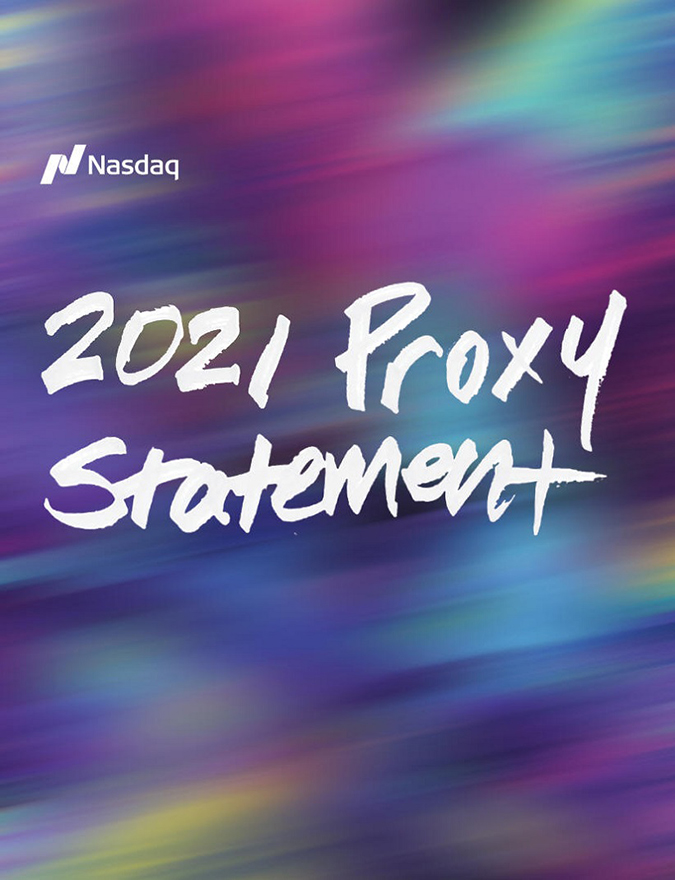
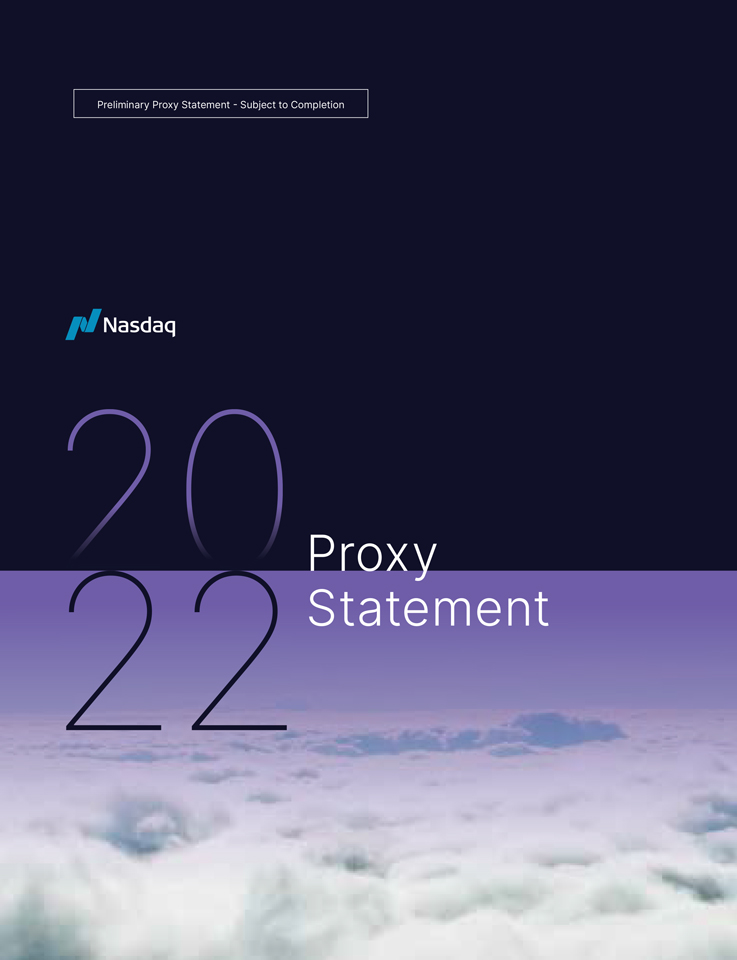




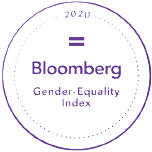




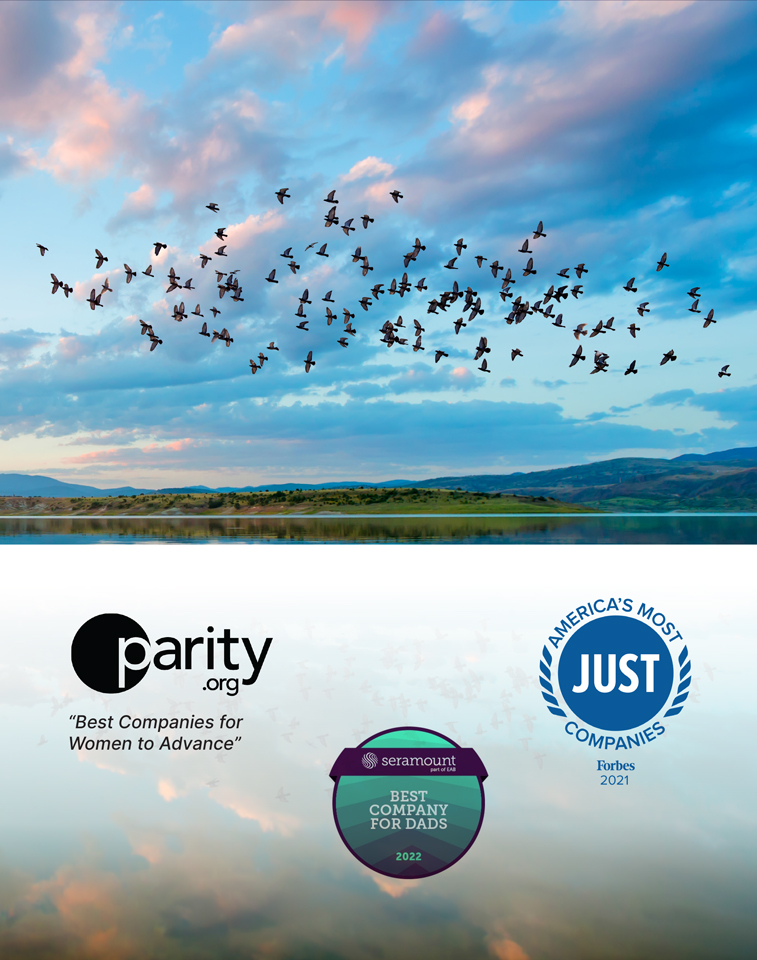
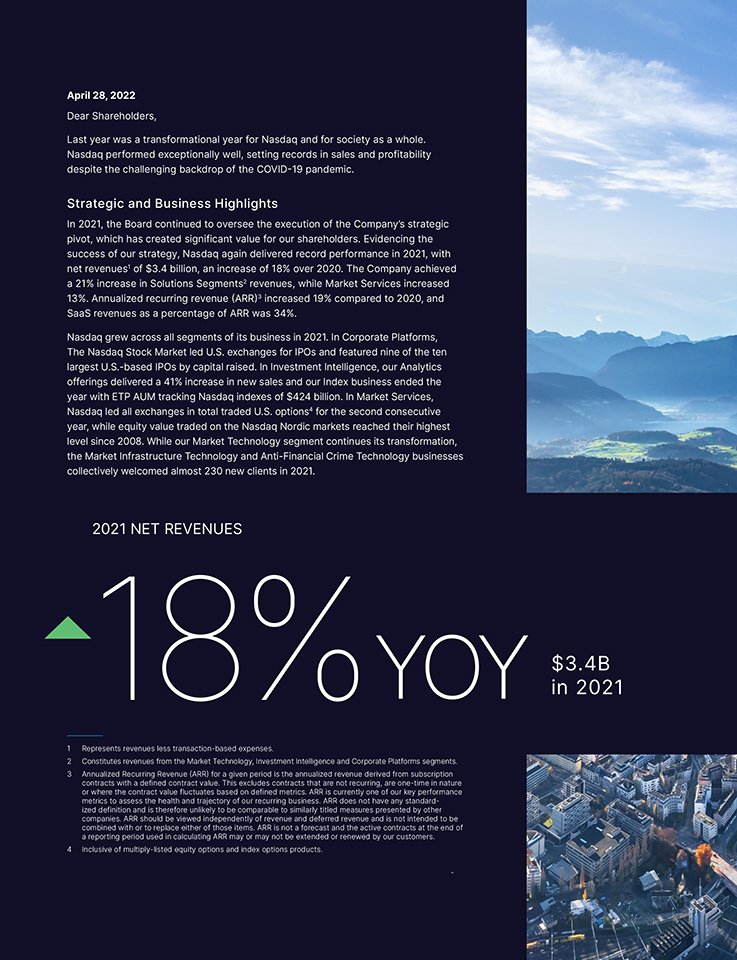
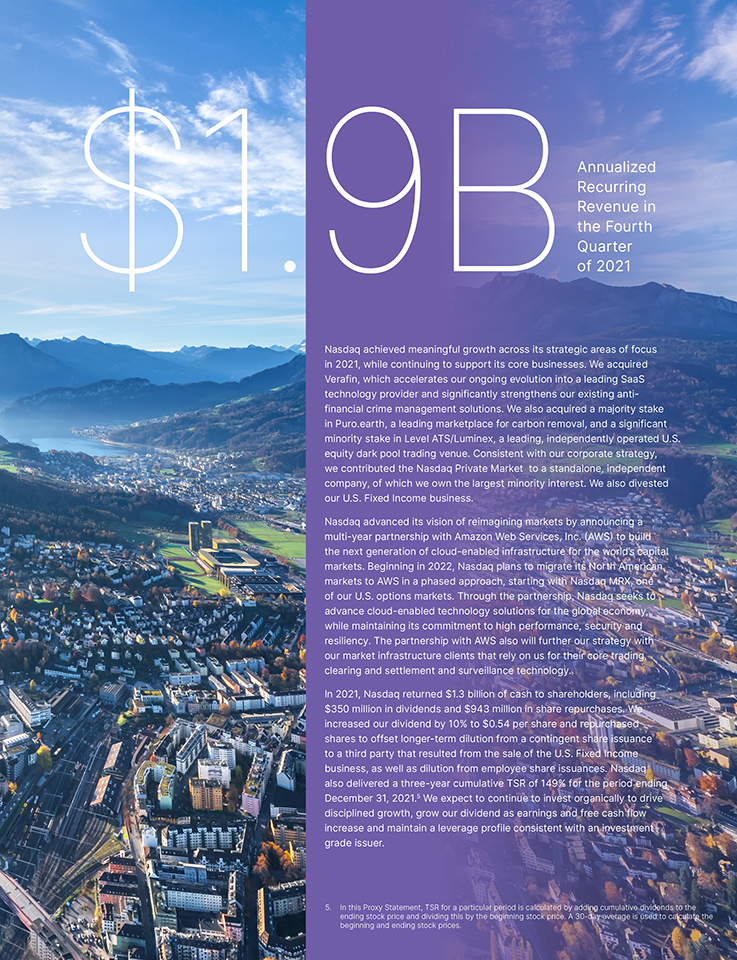
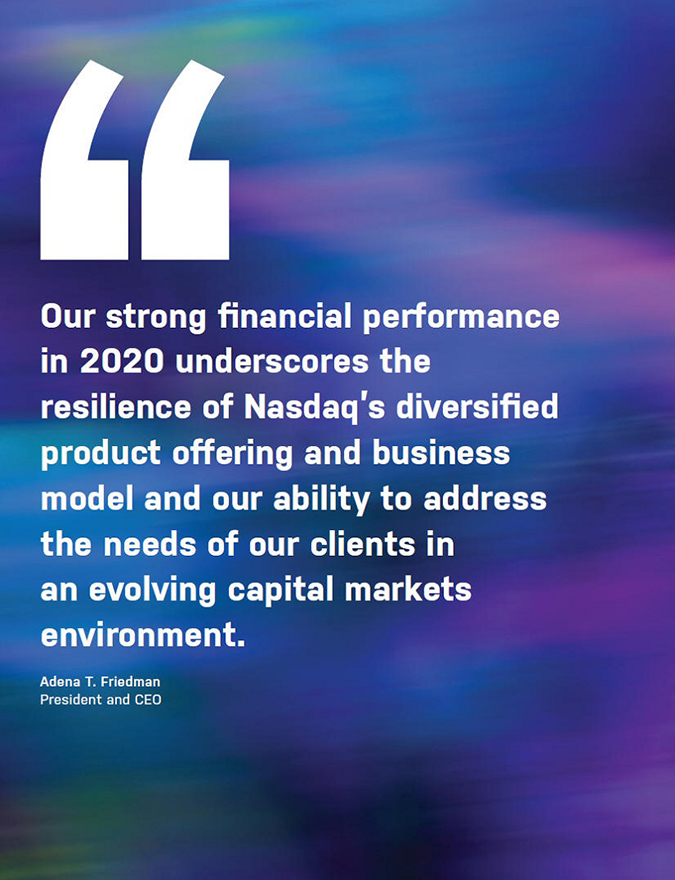

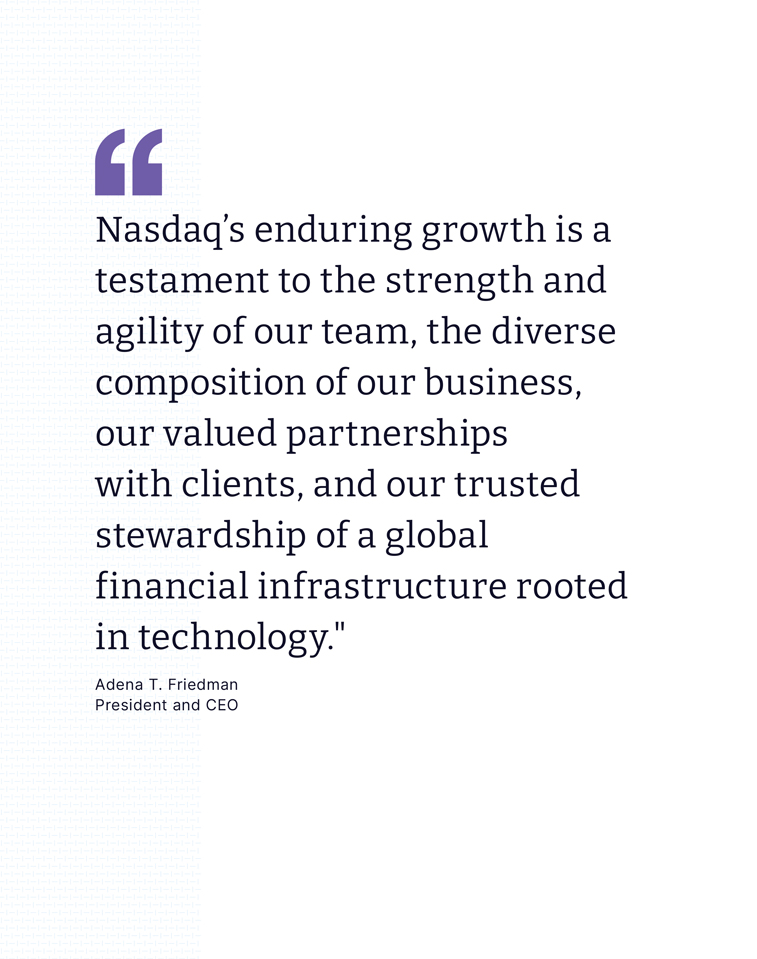






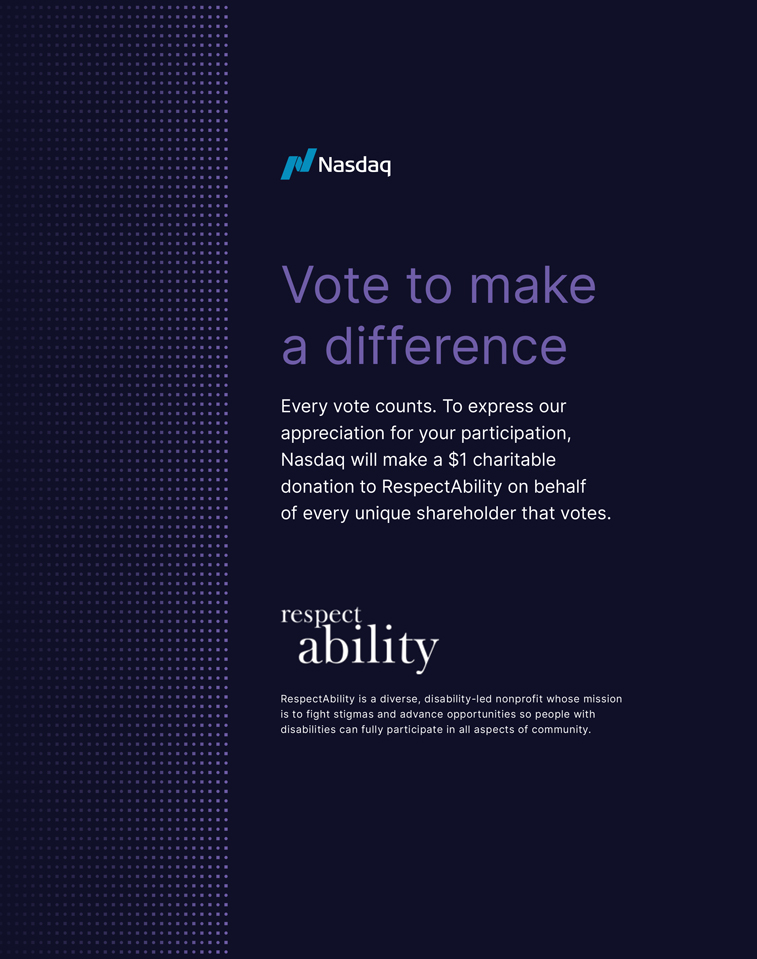
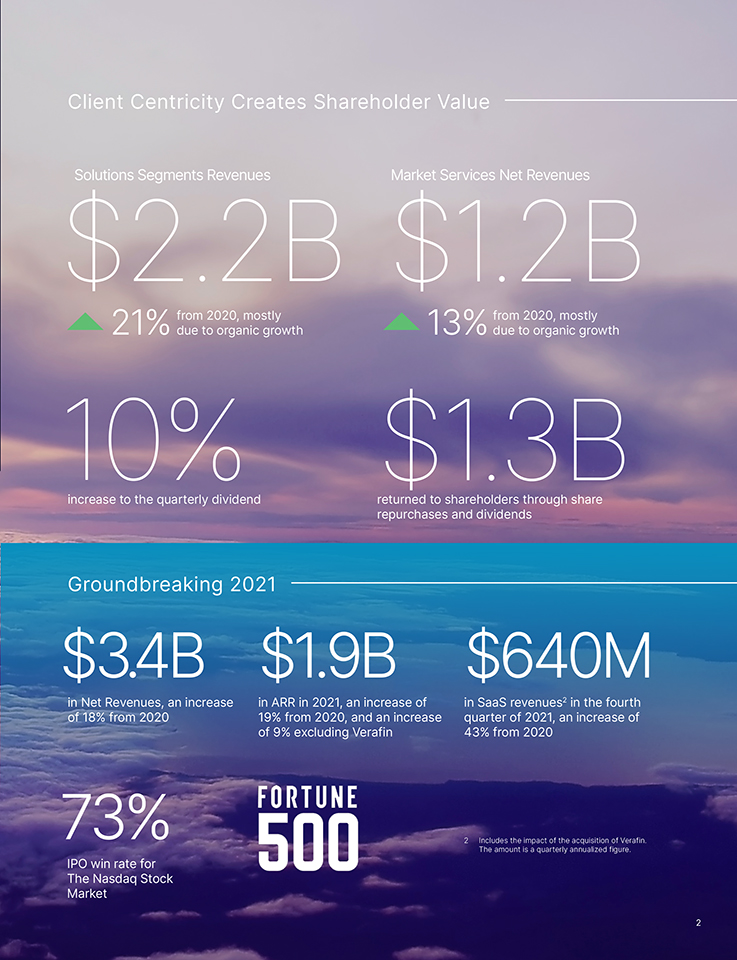







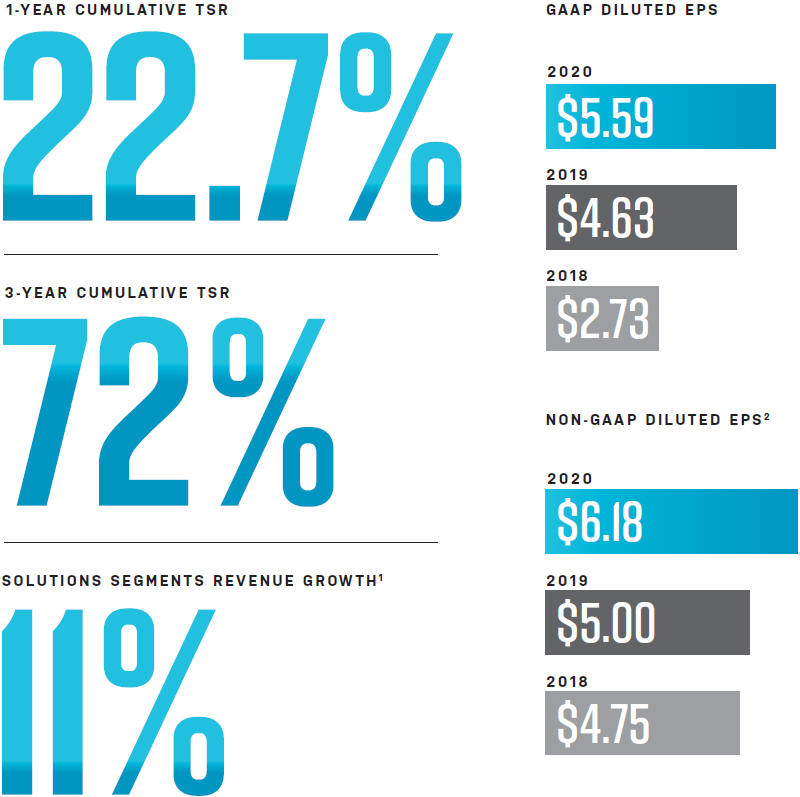


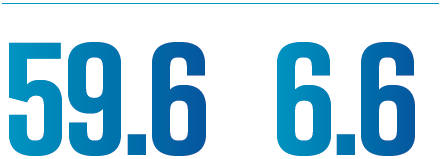

 Advanced our strategic positioning
Advanced our strategic positioning Increased our regular quarterly dividend by 4% to $0.49 per share,
Increased our regular quarterly dividend by 4% to $0.49 per share, Implemented modifications for all employees, including the NEOs, to our annual cash incentive program
Implemented modifications for all employees, including the NEOs, to our annual cash incentive program Actively conducted year-round planning for director succession and Board refreshment,
Actively conducted year-round planning for director succession and Board refreshment, Filed a proposal with the SEC to adopt new listing rules related to board diversity and disclosure
Filed a proposal with the SEC to adopt new listing rules related to board diversity and disclosure Published our workforce composition data
Published our workforce composition data  Strengthened and intensified our diversity and inclusion initiatives,
Strengthened and intensified our diversity and inclusion initiatives, Updated our Supplier Code of Ethics
Updated our Supplier Code of Ethics Enhanced our ESG disclosures
Enhanced our ESG disclosures Continued our
Continued our  Provided focused disclosure on the Board’s oversight of our response to
Provided focused disclosure on the Board’s oversight of our response to